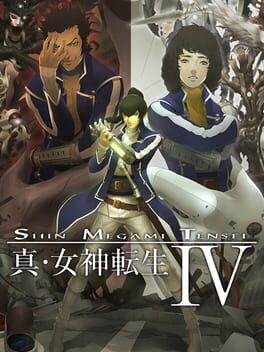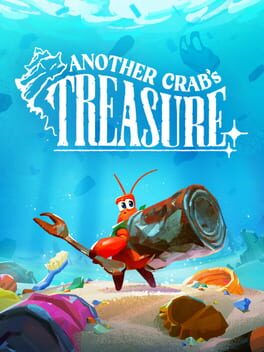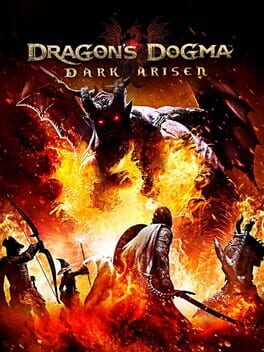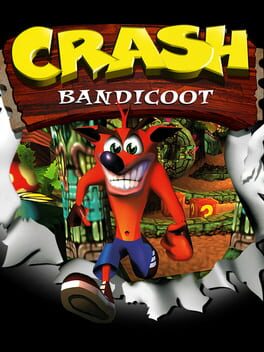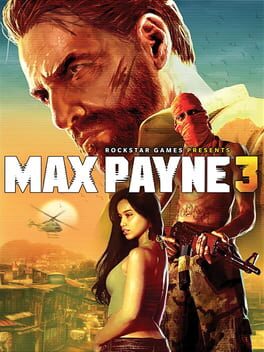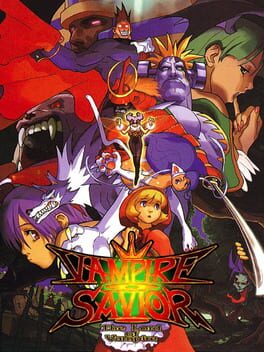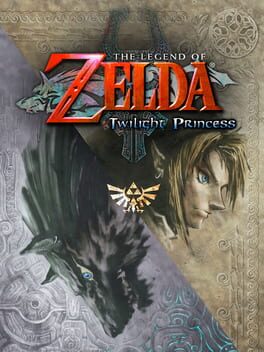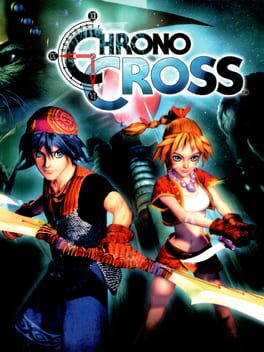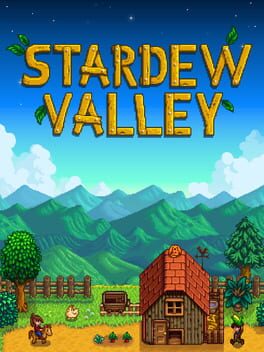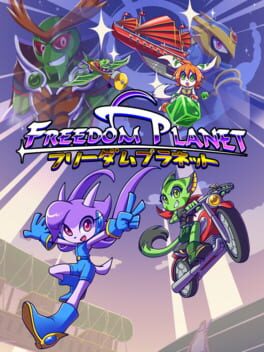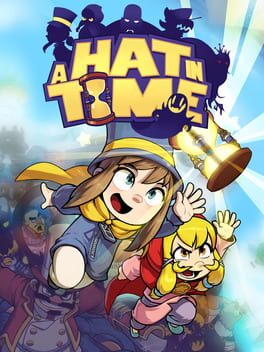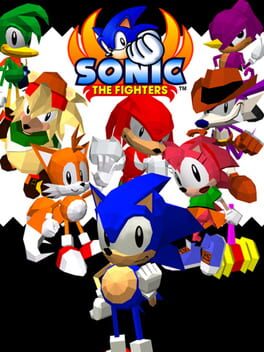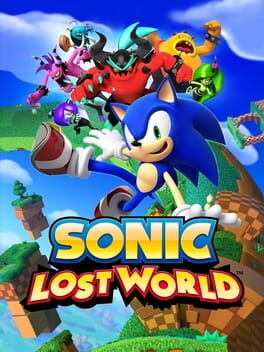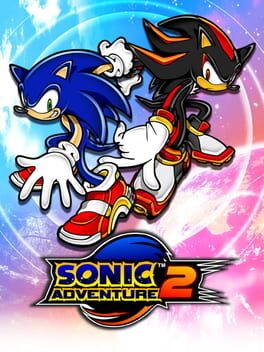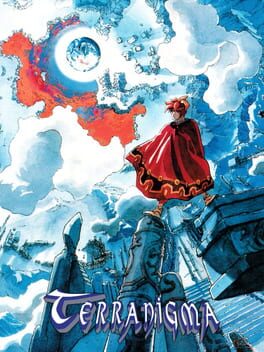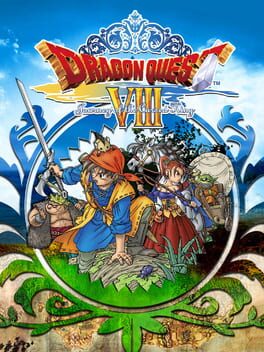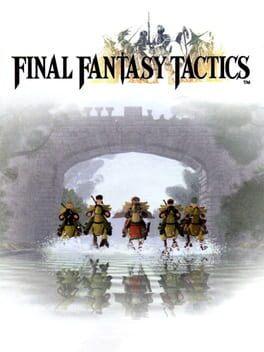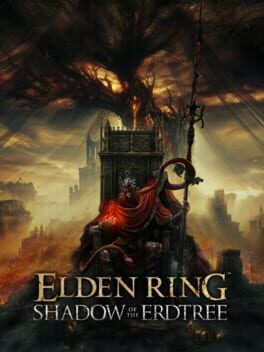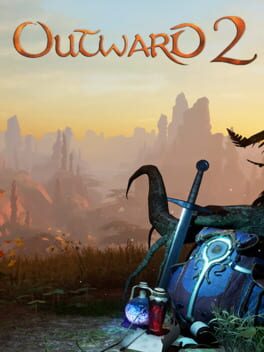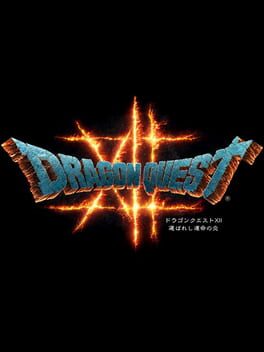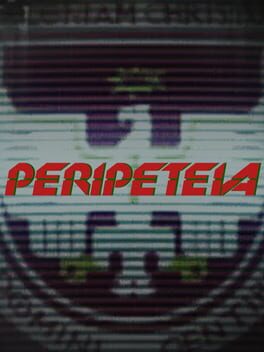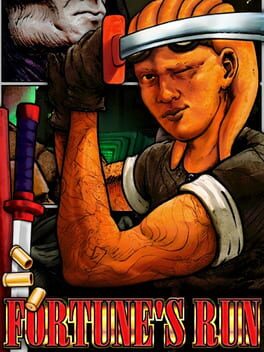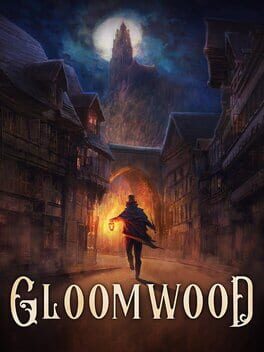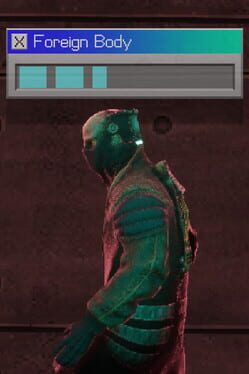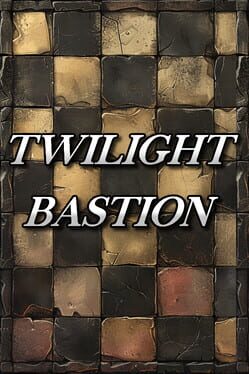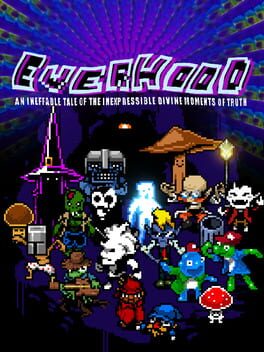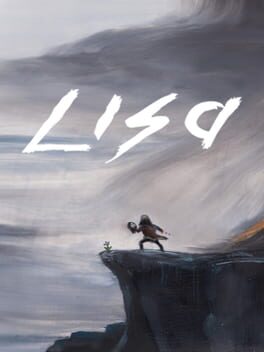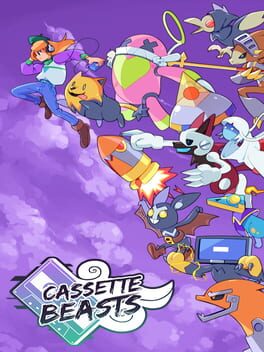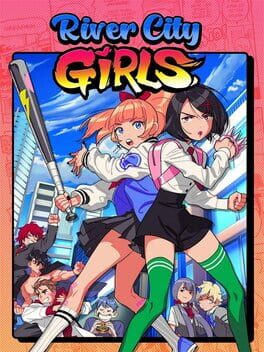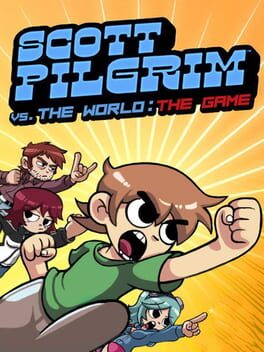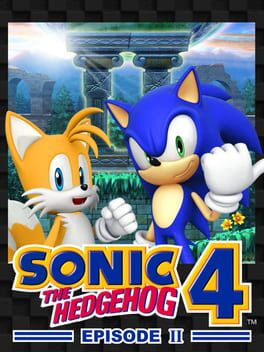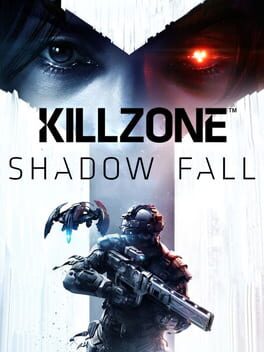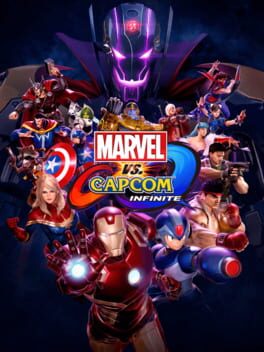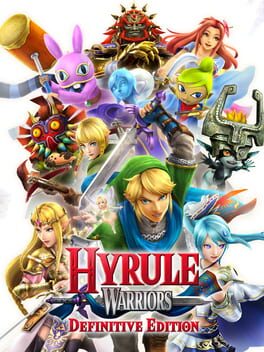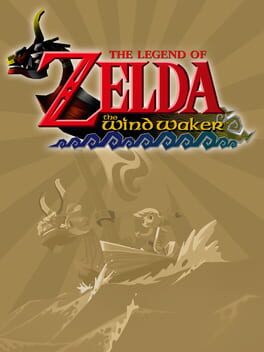sleepytitan
1586 reviews liked by sleepytitan
Sea of Stars
2023
Cool gameplay and graphics but this game is too self aware and embarrassed about what it is. It becomes insufferable with how many times they subvert your expectations out of fear of playing into tropes or cliches. It happens so often that it is just subverting for the sake of subverting, and leads to the game feeling narratively weightless. None of the characters are very good and the character design feels like it was solely made to inspire fan-art and head-canon to give them characterization.
Ironically, the more they subvert and self-reference tropes, the more generic and cliche they are. Except, those cliches only display a lack of confidence in your own abilities.
Ironically, the more they subvert and self-reference tropes, the more generic and cliche they are. Except, those cliches only display a lack of confidence in your own abilities.
Truly, am I at a complete loss of words. I will need to ruminate over this game before I can make a full review. Everything about it is so perfect. I admittedly have a handheld bias, as I far prefer to play games on a bigger screen, so the fact that this game has become my favorite of all time should say a lot of its quality. Everything is handled so masterfully. The designs, the dungeons, the gameplay, the world, the lore, the NPCs, the quests, the story, the characters, the dialogue, the themes, the alignments, the music, everything is so perfect. This captures the essence of Megami Tensei so flawlessly.
There is no greater feeling when your favorite game of all time is surpassed.
There is no greater feeling when your favorite game of all time is surpassed.
Unicorn Overlord
2024
Unicorn Overlord
Finished 5/4/24
As a fan of the tactics genre I sometimes have to face an unfortunate truth. I'm not really that smart. Denoting the tactics genre as something of an 'intelligent' genre isn't super productive or entirely all that honest but I think most people like to equate it as requiring a bit more patience and caution to every detail. The game of chess throughout history used as a paradigm of teaching tactical strategy, morality, higher thinking and the likes- unfortunately, in our middle school's gifted enrichment class I had the proud honor of being the 2nd worst chess player in our class ranking. I don't know, something about my planning functions just don't activate in the middle of a TRPG, sometimes becoming an issue in these tactical games. FFT, Capsule Monster Coliseum, Tactics Ogre- at least Fire Emblem's archetypal builds and borderline gambling chances have carved a niche in my brain as to how I proceed through those battlefields. It's a weird conflict of interest for me but one I enjoy wracking my brain with as the systems often take creative liberties to allow several different variables in handling their given puzzles. Leave it to Vanillaware to both alleviate on and twist the knife on this predicament.
Unicorn Overlord is a magnificent addition to the genre's canon, and would make a pretty good entry into the genre as of late, as Fire Emblem I feel has cornered itself in weird conflicting philosophies, in my opinion and other tactics franchises are mostly juggling through remakes at the moment. Ironic to recommend it as such given how much this game borrows from the canon wholesale, the gameplay is very much Ogre Battle 64, the world map and many plot beats reek of 16-bit Fire Emblem yet the later addition of Feather classes and Bestrals feel more akin to the Tellius titles. This is fairly typical for Vanillaware: Dragon's Crown, 13 Sentinels, Odin Sphere usually display their inspiration on their sleeve, although this still feels a bit more ‘prime’ for expansion but I'll elaborate later.
Props to Vanillaware having some of my favorite 'feel' in games. It's incredibly easy and satisfying going through VW interfaces. Something like 13 Sentinels being 90% narrative doesn't give you much to navigate, game-wise but even in a title such as that- it just feels smooth going through menus to find what you want. It should be a given that Vanillaware's attention to its art, its interfacing and music is top notch, just some of the best in the industry.
The world map is incredibly fun to explore, with the first nation providing a ton of features to interact with. Treasure maps, unmarked houses that give hidden items, different types of quests abound and town restorations to boost your renown, there’s a lot to clear out throughout Fevrith. I do wish later areas had more unique things to distinguish them, Drakengard gets a distinct coliseum but past that the latter nations feel a bit rinse and repeat. It's still fun to run around the new areas and there's some neat distinctions in later areas, Bastorias has a lot more harbors, Albion has goats? There's at least enough throughout the continent to explore and go back to once you acquire new units that can interact with certain markers, which freshens things up a little.
/////INTERMISSION///////
Selvie is best wife.
/////END INTERMISSION//////
I was worried the introduction of so many characters at once would have been an issue, and while it does front load you with several, several characters on the front end it more or less resembles a larger Fire Emblem title at around 70 characters (Radiant Dawn, Fates: Revelation and New Mystery range around 70-high 80s). It's still quite a lot, and not every character is an immediate winner but they've got some fun interactions and the amount of units you can use in battle allows for better expression of their character. This opposes certain titles like New Mystery of the Emblem, a game with several, several units at your disposal but only about 10 slots by the end game, 6 of which are pretty locked in, either for Marth/Kris or good ending requirements. Here, UO gives plenty of opportunity for you to build out self-sufficient teams as you unlock and expand your unit sizes and test them out in the main, side and liberation quests.
If Fire Emblem is a JRPG given a tactical playing field, Unicorn Overlord is a tactics programming game (apologies though, I have no experience with actual programming video games). Quite often I run into a situation where I throw a unit out into the battlefield, meet some friction and only halfway through a battle remember the spaghettified loadout I hadn't changed back from a previous battle. While the game has so many options and ways to customize your moveset, it only makes it easier to be bogged down by the potential of every variable rather than a clear solution. I do wish I utilized the loadouts more often, just to preserve a 'main' loadout and shift to certain other builds depending on the situation- didn't because I just, well, forgot…The game isn’t all that hard, not when you really get down into the meat of it all, but I admittedly felt pretty stupid at a lot of points trying to organize certain skills together only for the main issue to be something like character placement in a unit. Thankfully Vanillaware's ethos of providing a lot of items and secondary abilities somewhat mitigates sticky situations- it just kinda feels sillier when resorting to certain items for beating hordes of units when the outlook of a fight doesn't look favorable. The perfect result forecast is a godsend of a feature though, giving no hang ups as to how a battle might go but letting you know completely if you’ll get a good outcome in a fight. The only issue being its not precise in letting you know what damage or healing goes where, the results mostly act as a total ‘healing’ or damage so it pays to pay attention because too often i saw i was getting healed, went into battle only for a unit to take 16 damage and die but someone else to be healed 32 HP for a result of 16 healing, very perplexing.
At the very least this differs from my frustrations with FE: Engage, where I would often struggle with an in-game currency as to whether certain builds would be a waste of both time and experience. Here, it was more so just a confusion on smart, optimal, loadouts for certain units I probably didn't need battling certain other enemies in the first place. It admittedly took me a while to remember how exactly best to counter Wyvern Riders...
I do give props for the game utilizing various cliques/design elements from Fire Emblem's classes, although some of the same pitfalls apply as well. Bulkier, defensive units like Hoplites don't feel nearly as useful as Cavalier or Flying units- hell Cavelier units are certainly the best of the bunch here. Most every class is pretty alright though, I was able to make one of my units using Bruno despite seeing a lot of pushback on Gladiators, which might speak to how malleable and gameable the systems are here.
This feels like an odd inverse to Vanillaware's previous opus, 13 Sentinels, a title I honor in its densely layered, memetic entanglement of a narrative, but somewhat spartan in its tactical, wave management mode (fantastic music at least). Unicorn Overlord, despite its immense equipment-moveset-placement management and its abundance of items for tactical deployment has a fairly milquetoast narrative. It works, although I wouldn't say it strikes me as hard as some of my more favorite Fire Emblem titles or most of what I've played of FF Tactics. It's a bit hard to place as the game's heavy reliance on other games in the genre made it harder to really place my head separate from the parallels. Additionally, while I enjoy the methodical pace of going country by country to liberate Fevrith, many of the quests and fights began feeling pretty cut and dry rather than having a living, dynamic narrative that felt impacted by the progress of your crusade. You make a good chunk of progress through the mainland of Cornia, approximately freeing a quarter of the continent yet even with this massive chunk it feels a bit silly that there's still 4 major countries propping up these major occupants in the other nations. I guess there's mind-control-curse type shenanigans to fall back on for why you still need to go to each of the nations but it's funny when looking at the big picture. There’s a big lore drop around the last single digit percent of the game, and granted it's a neat explanation as to why the events have unfolded, it just feels too little for too late.
The main thing I want to impart is that this game is quite excellent on most fronts- it's perhaps a nation and a half too long though. The novels of the world, all the classes, the battling, the equipment swapping gets to be pretty redundant once you hit Bastorias. By then, a lot of the classes introduced start to feel like repeats of prior classes, a reskin of thieves, two reskins of archers, a hoplite reskin, etc. Looking closer these do have their distinct differences of course, some of which have better synergy than their compatriot but it feels harder at first glance to determine how to fit in these newer classes and playstyles, often I figure it best to just lump all of one region's new characters into their own unit and call it a day.
It is a shame, I doubt this'll see a sequel or follow up of any sort given that usually Vanillaware deals in one and done titles. While I don't necessarily want something on the same length, I think there's a lot that could be done to iron out some of the kinks of the unit/inventory management while expanding upon the way this interacts in the narrative. Nothing feels quite as good as changing that one variable in a loadout and making a battle go from a close shave to a complete trample, although by the third act much of the time it feels more like you’re plodding through useless trinkets for the specific battle while on the grand scheme of the game the fighting has stalled in narrative momentum.
I mentioned earlier VW's penchant to have games wear a patchwork sweater of references, and while UO isn't innocent of this I feel as though it not as ‘contained’ as something like a 13 Sentinels- a narrative that feels more open and closed by that game’s finale. I could earnestly see something at least in the same universe or style to Unicorn Overlord, although i don't know if they’d need to go through the same hoops as each FE continuity needing a ‘Fire Emblem’. Perhaps it's just that I felt left wanting a bit more on the narrative end, but I could go for another tactics title from Vanillaware, it checks a lot of things I’ve been wanting from Fire Emblem for a while.
Unicorn Overlord is a massive ordeal in tactical thinking, allowing for the customization of several cogs to trample armies, somewhat undermined by the ease of having so many options that forego needing to engage with the usual risks in the genre and running low on steam by the last continent.
Finished 5/4/24
As a fan of the tactics genre I sometimes have to face an unfortunate truth. I'm not really that smart. Denoting the tactics genre as something of an 'intelligent' genre isn't super productive or entirely all that honest but I think most people like to equate it as requiring a bit more patience and caution to every detail. The game of chess throughout history used as a paradigm of teaching tactical strategy, morality, higher thinking and the likes- unfortunately, in our middle school's gifted enrichment class I had the proud honor of being the 2nd worst chess player in our class ranking. I don't know, something about my planning functions just don't activate in the middle of a TRPG, sometimes becoming an issue in these tactical games. FFT, Capsule Monster Coliseum, Tactics Ogre- at least Fire Emblem's archetypal builds and borderline gambling chances have carved a niche in my brain as to how I proceed through those battlefields. It's a weird conflict of interest for me but one I enjoy wracking my brain with as the systems often take creative liberties to allow several different variables in handling their given puzzles. Leave it to Vanillaware to both alleviate on and twist the knife on this predicament.
Unicorn Overlord is a magnificent addition to the genre's canon, and would make a pretty good entry into the genre as of late, as Fire Emblem I feel has cornered itself in weird conflicting philosophies, in my opinion and other tactics franchises are mostly juggling through remakes at the moment. Ironic to recommend it as such given how much this game borrows from the canon wholesale, the gameplay is very much Ogre Battle 64, the world map and many plot beats reek of 16-bit Fire Emblem yet the later addition of Feather classes and Bestrals feel more akin to the Tellius titles. This is fairly typical for Vanillaware: Dragon's Crown, 13 Sentinels, Odin Sphere usually display their inspiration on their sleeve, although this still feels a bit more ‘prime’ for expansion but I'll elaborate later.
Props to Vanillaware having some of my favorite 'feel' in games. It's incredibly easy and satisfying going through VW interfaces. Something like 13 Sentinels being 90% narrative doesn't give you much to navigate, game-wise but even in a title such as that- it just feels smooth going through menus to find what you want. It should be a given that Vanillaware's attention to its art, its interfacing and music is top notch, just some of the best in the industry.
The world map is incredibly fun to explore, with the first nation providing a ton of features to interact with. Treasure maps, unmarked houses that give hidden items, different types of quests abound and town restorations to boost your renown, there’s a lot to clear out throughout Fevrith. I do wish later areas had more unique things to distinguish them, Drakengard gets a distinct coliseum but past that the latter nations feel a bit rinse and repeat. It's still fun to run around the new areas and there's some neat distinctions in later areas, Bastorias has a lot more harbors, Albion has goats? There's at least enough throughout the continent to explore and go back to once you acquire new units that can interact with certain markers, which freshens things up a little.
/////INTERMISSION///////
Selvie is best wife.
/////END INTERMISSION//////
I was worried the introduction of so many characters at once would have been an issue, and while it does front load you with several, several characters on the front end it more or less resembles a larger Fire Emblem title at around 70 characters (Radiant Dawn, Fates: Revelation and New Mystery range around 70-high 80s). It's still quite a lot, and not every character is an immediate winner but they've got some fun interactions and the amount of units you can use in battle allows for better expression of their character. This opposes certain titles like New Mystery of the Emblem, a game with several, several units at your disposal but only about 10 slots by the end game, 6 of which are pretty locked in, either for Marth/Kris or good ending requirements. Here, UO gives plenty of opportunity for you to build out self-sufficient teams as you unlock and expand your unit sizes and test them out in the main, side and liberation quests.
If Fire Emblem is a JRPG given a tactical playing field, Unicorn Overlord is a tactics programming game (apologies though, I have no experience with actual programming video games). Quite often I run into a situation where I throw a unit out into the battlefield, meet some friction and only halfway through a battle remember the spaghettified loadout I hadn't changed back from a previous battle. While the game has so many options and ways to customize your moveset, it only makes it easier to be bogged down by the potential of every variable rather than a clear solution. I do wish I utilized the loadouts more often, just to preserve a 'main' loadout and shift to certain other builds depending on the situation- didn't because I just, well, forgot…The game isn’t all that hard, not when you really get down into the meat of it all, but I admittedly felt pretty stupid at a lot of points trying to organize certain skills together only for the main issue to be something like character placement in a unit. Thankfully Vanillaware's ethos of providing a lot of items and secondary abilities somewhat mitigates sticky situations- it just kinda feels sillier when resorting to certain items for beating hordes of units when the outlook of a fight doesn't look favorable. The perfect result forecast is a godsend of a feature though, giving no hang ups as to how a battle might go but letting you know completely if you’ll get a good outcome in a fight. The only issue being its not precise in letting you know what damage or healing goes where, the results mostly act as a total ‘healing’ or damage so it pays to pay attention because too often i saw i was getting healed, went into battle only for a unit to take 16 damage and die but someone else to be healed 32 HP for a result of 16 healing, very perplexing.
At the very least this differs from my frustrations with FE: Engage, where I would often struggle with an in-game currency as to whether certain builds would be a waste of both time and experience. Here, it was more so just a confusion on smart, optimal, loadouts for certain units I probably didn't need battling certain other enemies in the first place. It admittedly took me a while to remember how exactly best to counter Wyvern Riders...
I do give props for the game utilizing various cliques/design elements from Fire Emblem's classes, although some of the same pitfalls apply as well. Bulkier, defensive units like Hoplites don't feel nearly as useful as Cavalier or Flying units- hell Cavelier units are certainly the best of the bunch here. Most every class is pretty alright though, I was able to make one of my units using Bruno despite seeing a lot of pushback on Gladiators, which might speak to how malleable and gameable the systems are here.
This feels like an odd inverse to Vanillaware's previous opus, 13 Sentinels, a title I honor in its densely layered, memetic entanglement of a narrative, but somewhat spartan in its tactical, wave management mode (fantastic music at least). Unicorn Overlord, despite its immense equipment-moveset-placement management and its abundance of items for tactical deployment has a fairly milquetoast narrative. It works, although I wouldn't say it strikes me as hard as some of my more favorite Fire Emblem titles or most of what I've played of FF Tactics. It's a bit hard to place as the game's heavy reliance on other games in the genre made it harder to really place my head separate from the parallels. Additionally, while I enjoy the methodical pace of going country by country to liberate Fevrith, many of the quests and fights began feeling pretty cut and dry rather than having a living, dynamic narrative that felt impacted by the progress of your crusade. You make a good chunk of progress through the mainland of Cornia, approximately freeing a quarter of the continent yet even with this massive chunk it feels a bit silly that there's still 4 major countries propping up these major occupants in the other nations. I guess there's mind-control-curse type shenanigans to fall back on for why you still need to go to each of the nations but it's funny when looking at the big picture. There’s a big lore drop around the last single digit percent of the game, and granted it's a neat explanation as to why the events have unfolded, it just feels too little for too late.
The main thing I want to impart is that this game is quite excellent on most fronts- it's perhaps a nation and a half too long though. The novels of the world, all the classes, the battling, the equipment swapping gets to be pretty redundant once you hit Bastorias. By then, a lot of the classes introduced start to feel like repeats of prior classes, a reskin of thieves, two reskins of archers, a hoplite reskin, etc. Looking closer these do have their distinct differences of course, some of which have better synergy than their compatriot but it feels harder at first glance to determine how to fit in these newer classes and playstyles, often I figure it best to just lump all of one region's new characters into their own unit and call it a day.
It is a shame, I doubt this'll see a sequel or follow up of any sort given that usually Vanillaware deals in one and done titles. While I don't necessarily want something on the same length, I think there's a lot that could be done to iron out some of the kinks of the unit/inventory management while expanding upon the way this interacts in the narrative. Nothing feels quite as good as changing that one variable in a loadout and making a battle go from a close shave to a complete trample, although by the third act much of the time it feels more like you’re plodding through useless trinkets for the specific battle while on the grand scheme of the game the fighting has stalled in narrative momentum.
I mentioned earlier VW's penchant to have games wear a patchwork sweater of references, and while UO isn't innocent of this I feel as though it not as ‘contained’ as something like a 13 Sentinels- a narrative that feels more open and closed by that game’s finale. I could earnestly see something at least in the same universe or style to Unicorn Overlord, although i don't know if they’d need to go through the same hoops as each FE continuity needing a ‘Fire Emblem’. Perhaps it's just that I felt left wanting a bit more on the narrative end, but I could go for another tactics title from Vanillaware, it checks a lot of things I’ve been wanting from Fire Emblem for a while.
Unicorn Overlord is a massive ordeal in tactical thinking, allowing for the customization of several cogs to trample armies, somewhat undermined by the ease of having so many options that forego needing to engage with the usual risks in the genre and running low on steam by the last continent.
An interesting cross between a soulslike and a lighthearted 3D platformer. It’s clear where its influences lie and I kinda feel it rides the line between being inspired and just copying stuff (“The Sands Between” is not very subtle for instance), but for the most part it stands out as its own thing and enjoyable
It draws from many of FromSoft’s titles obviously (specifically Sekiro with the addition of parries and a stance meter which works well enough here), but the use of shells that give different stats and special abilities added a good amount of variety to combat despite being limited to just your fork. Can also make it into a hammer weapon by attaching shells to it which was cool
Aesthetically SpongeBob comes to mind along with Battle for Bikini Bottom in how it plays as a platformer, but that’s an easy comparison to make really (even has a Mr. Krabs costume you can wear). I thought Kril was a bit obnoxious past the whole playing as a crab novelty, but the sea world and dialogue were charming enough. It’s a surprisingly sizable game too, took about 20 hours to finish
What holds it back though is mainly a general lack of polish. Mechanically it doesn’t really match the refinement of its contemporaries, combat and platforming has an ever present feeling of jank to it that just gets more noticeable the longer you play. Numerous times I’ve gotten stuck on terrain, dodges or parries can be inconsistent to register, the camera tends to bug out especially when you’re often in enclosed areas, for some reason using the hammer would launch Kril into the air sometimes, occasionally the audio would cut out entirely unless I restarted the game, etc. I’ve heard performance is rough on console platforms also, but was mostly alright on Steam Deck for me so can’t really verify that. These are all things that can be improved with patches at least, so hopefully it gets more work there over time
It draws from many of FromSoft’s titles obviously (specifically Sekiro with the addition of parries and a stance meter which works well enough here), but the use of shells that give different stats and special abilities added a good amount of variety to combat despite being limited to just your fork. Can also make it into a hammer weapon by attaching shells to it which was cool
Aesthetically SpongeBob comes to mind along with Battle for Bikini Bottom in how it plays as a platformer, but that’s an easy comparison to make really (even has a Mr. Krabs costume you can wear). I thought Kril was a bit obnoxious past the whole playing as a crab novelty, but the sea world and dialogue were charming enough. It’s a surprisingly sizable game too, took about 20 hours to finish
What holds it back though is mainly a general lack of polish. Mechanically it doesn’t really match the refinement of its contemporaries, combat and platforming has an ever present feeling of jank to it that just gets more noticeable the longer you play. Numerous times I’ve gotten stuck on terrain, dodges or parries can be inconsistent to register, the camera tends to bug out especially when you’re often in enclosed areas, for some reason using the hammer would launch Kril into the air sometimes, occasionally the audio would cut out entirely unless I restarted the game, etc. I’ve heard performance is rough on console platforms also, but was mostly alright on Steam Deck for me so can’t really verify that. These are all things that can be improved with patches at least, so hopefully it gets more work there over time
wheatie the Peach Stan is still very much alive a month and a half later, here to tell you all about Super Princess Peach: Parasol Fall for the Adobe Flash Player. It's not very good.
As silly as I think it is having "Princess Peach" be its own series on here with only three games, one of which being this one, I'll admit that I probably wouldn't have found this game if it weren't for the new feature. Proud to say I now have the full Princess Peach experience.
As silly as I think it is having "Princess Peach" be its own series on here with only three games, one of which being this one, I'll admit that I probably wouldn't have found this game if it weren't for the new feature. Proud to say I now have the full Princess Peach experience.
In a 2013 GDC talk on the development of Dragon’s Dogma. The director Hideaki Itsuno wanted specific principles: “high degree of freedom, simple action, highly realistic.” With examples: Elder Scrolls Oblivion, Fallout 3, and Fable 2. Disclosing their units shipped and the same quality/s each possesses. These three aspects I'm quite fond of. With the first as numero uno what I look for. Freedom. Always. His “job was to convince internal members of Capcom that this is a challenge he wanted to take on. Similar games in this open world RPG genre didn't really exist in Japan. And they weren’t able to accurately forecast if the project would sell or the market potential.”
I couldn’t help but remember a comparable individual I look up to, Tetsuya Takahashi. The man behind the creation of the Xeno series along with his team and his wife Soraya Saga. In a 2015 Venturebeat interview he answered a question on what is the "biggest difference between Western and Japanese audiences, especially in terms of what they want from a role-playing game?” Takahashi said “What you’ll find quite often is that a lot of the markets outside of Japan are interested in games where you can do anything you want. They put a high priority on a great degree of freedom. In the Japanese market, it’s more common for people will demand a certain flow to the events in a game. We find that they’re more comfortable with a linear framework. We have our theories about why this might be.”
The comparison is relative due to the creators of their respective franchises aspiring to replicate near identical reception and appeal within their works. To differing results. Moving outside their comfort zone creating a fusion in a way. As much as I would revel in going off on Xenoblade Chronicles X, that’s a story for another time. Among the challenges and expectations, Itsuno is trying to match Skyrim’s massive reception with Dragon’s Dogma. An ambitious endeavor I appreciate as he remarks transparently in March 20, 2012. “At Capcom, we’ve made Dragon’s Dogma and come up to this point through our experience of action games. We’re trying to make a new genre: We’re using our action heritage and putting that into an action RPG.”
Emphasizing “changing action RPG to ACTION rpg.” Going for ambition is not inherently wrong. Great to have these goals to strive towards. As long as they stick the landing, journey and beginning. And I must say, after 3 playthroughs. One on normal, on hard mode, and finishing a speedrun whilst completing everything I can in postgame and the DLC on Bitterback isle of the Dark Arisen version, I firmly believe they succeeded in accomplishing all three qualities. However, despite my abundant enjoyment I did come across a sizable bulk of concerns I’ll discuss later in my mixed feelings. For now, I’ll discuss immediate sections I love.
Freedom is unrestricted. You can forget the main quest and go gallivanting off the beaten path and run towards any place on the map. Delving freely into dark dungeons, rocky caverns or forgotten ruins where a lantern is a must to combat the darkness. Filled with a plethora of variable attackers you won’t usually see copy-paste monsters on a budget. Harpies, undead skeletons, zombies, knights, mages, bandits, goblins, liches, ghosts, ogres, and etc. Even their variants are suitable. Clashing heavyweights against yours. Thus I can’t complain on the diverse enemy enriching every location you stumble in your wanderlust. Speaking of stumbling, you can upon completing a small bit of central plot early on set your fast travel points within reason. I didn’t like the approach since you receive a limited lot but ultimately came around to liking the unorthodox system. Helped by the fact the world didn’t feel too huge to traverse. Nor too meager to explore the sum of the whole caboodle within a short amount of time. Instead, the locales are filled with interesting locations. Multiple medium to large-scale dungeons displaying serviceable level design beyond linear corridors. Plenty of paths to tread both up and down. Breathtaking scenery during adventures. Bluemoon Tower made me feel as if I was transported in Rome’s Colosseum except fantasied. Ruined in decay where a single step can lead to certain death. Or embark on a long fog-filled forest where directions can prove futile for a newbie traveler. Yet for the experienced, hitting misty poles can unveil the true path. Mayhaps you will partake in a water temple? Which by the gods isn’t as arduous as other infamous water temples in games I’ve played. Link would breathe a sigh of relief here. Levers and switches to change the water level. Or for the speedy, they can excuse the routes and with careful jumping reach the end of the dungeon. Outside the danger is palpable with special zones where never-before-seen creatures lurk. Dangerous lichs and small drakes patrol. A functional day/night cycle capable of giving goosebumps if you decide to tackle the absence of sun with naught but your companions along. Hopefully, you brought ample oil flasks for your lantern. Cause oh boy does the night present dangerous adversaries not just in a greater supply of darker denizens but boss behemoths roaming the lands. Reminded me a bit of turning tail and running towards safety amid the nights in Dying Light. Seeing a chimera pop up near my location still gives me shivers…
Additionally changing vocations called classes and specializing in whatever playstyle you so choose is near-painless. Parallel to the weapon classes from Monster Hunter, but different. As you kill bounties of opponents and level up your vocation rank, unlock new skills and abilities. Allowed me to play as a mystic knight capable of dishing out spells while tanking with a shield and upon switching my staff in the menu. I return, bashing heads without remorse. Each class is satisfying with strengths and weaknesses. I honestly didn’t expect to fancy bow and arrows, and DD made me a fan of archery. What the heck man? I was a longtime Greatsword user.Heck, you can grab and climb any large creature during conflicts whenever. Hiroyuki Kobayashi, the producer said in an 2011 Siliconera interview. How DD’s grab mechanic in addition to “...the main character can go and do whatever he wants in this world, it gave birth to the idea that he’s fighting enemies and he should be able to fight them in any way that he wants and so we came up with the idea of the grabbing mechanic. He can climb on these enemies and fight them however he chooses.” A defining trait adding an essential option for players to tactfully embrace a closer savage quarrel against any terrifying freaks. Though the concept isn’t fresh, Shadow of the Colossus(SOTC) requires players to climb and weaken a colossus by striking their weak-spots. The influence I feel resonates still with characters conducting similar operations. If I am climbing a Cyclops then surely the eye is the weakness right?! Yes! Chimera for instance as an early boss functions in a comparable manner. Slay the snake tail, to make climbing safer. Hitting the goat head silences spells, then bashed the lion head to finish off the triple threat in a single body. Refreshing to play an open realm granting players simple mechanics and then shooing them off, if they decide not to embrace the major narrative at will.
For folks who don’t know the premise is simple and lightly intriguing. Within a small village called Cassardis you(after creating your protagonist) live a relatively normal life. Until one day. A BIG RED DRAGON starts scorching your fellow villagers on the nearby beach. Wreaking havoc. Heart pounding you decisively run out. Brandish a rusted sword and try to fight off the savage dragon. You can undoubtedly realize how such an encounter fared. Very poorly. We lose our life. But wait! We are alive? The dragon decides to steal our ‘heart’ literally. And some way, somehow we are alive as “Arisen” A human being whose destiny is tied to stopping the dragon. Welp, there goes my regular routine. I already had plans for. Although facing the dragon is the least of our concerns, immediately you are bombarded with new main and side quests to undertake at your leisure. And it is here where the realistic portion emerges.
Highly realistic is accurate. For better or worse, everything operates and contributes to the unique presentation. Resembling real life, a black market exists for counterfeiting necessities. Try saving key special quest items instead of returning them to the owner. Giving them a pale counterpart. The outcome may raise eyebrows. Moving on, all items have weight. Healing, tools and materials are not spared. Gathering materials takes time. Thankfully not too slow and not too fast. I mentioned the grab mechanic earlier, but just as you are provided the ability to climb onto giants, so too do they have the innate ability to pin you down in their grasp! Best to keep on the move Arisen! Lest you fall into their hands! Stamina(ST) is your lifeline. Every weapon ability used will deplete a small portion of your gauge. Sprinting slowly depletes it. Running then jumping can induce a noticeable chunk gone. Don’t forget grabbing is affected. And behind a hidden blindspot. Your height and weight matter too. Being a figure with low density grants the highest stamina regen and the lowest encumbrance(Volume you can carry). Attaining a higher amount of body load causes you to restore a bit slower, on the offset causes you to be granted extra capacity for ST and encumbrance. Here is a chart for reference. Height also plays a key role. Being of a minimal stature allows entrance upon tiny openings and perhaps smaller hitboxes. Whereas a tall guy cannot enter limited spaces. Will have the inverse effect of hitboxes. Forget plans to go underneath a Cyclops as a six footer fella. If you thought that was the term of the realistic portion. Think again. Encumbrance affects all the above. Here is another chart for reference. Depending on how your current carry load. From ultra light to over-encumbered. Parameters in values will alter jogging & running speed, recovery time, climbing, carrying, grapple, and running. Naked for instance will have little to no penalty. Can grapple giants for the longest, run for an extended period along with moving at the fastest speed. Compared to a heavy individual. Oh man, you’ll be as slow as molasses. Not to that extent, but a noticeable degree changes with whatever you do. Finding yourself out of breath easily. Constantly recharging your gauge and good lord don’t get me started on the inability to pick up items except for several exceptions. Not strictly a requirement to understand these mechanics as you assemble your character and comrade. To the surface-level player, but to those who love knowing every itty bitty detail, they prove their tonnage in gold. Attention to detail in weight, height, ST and encumbrance demonstrates a philosophy that is neither half-baked nor too overly complicated. Functions as a well-oiled cog with alternative core features the developers are trying to convey. Such as a satisfying fight loop.
Action albeit simplified achieves hallmark makings of a gratifying beast slaying loop. Imagine facing a near insurmountable boss only to win succeeding ‘x’ or ‘xx’ amount of tries. Hmm, I’m reminded of Hidetaka Miyazaki’s Soul series. Good. That works. Broadening your horizons then, input a hardy challenger with a health bar and conjure the memory of facing a troublesome 2+ health bar encounter. That too is acceptable. Finally, remember how Monster Hunter immersified you to hunt, check for clues then melee and perhaps trail a weakened creature? Well, erase the busy work and focus on the bout. Hit any usable abilities with the smash of a button. 3 or six depending on the class provided. Sure it uses stamina, but the expense is negligible unless spammed. An immediate gratification than a delayed response. A real-time shift to having the ideal battles in Dragon’s Dogma. Except missing a couple major details. You. Are. Not. Alone. Pawns are lifelong companions. A main pawn is always at your side. With two spares you can summon in through an online feature. Connecting online accommodates your world a random assortment of online pawns. No need returning to base and recruit, simply talking with them and as long as they meet your current level. A free no cost sign-up to your party begins. Thus, clashes against adversaries transform regular duels into a group brawl. Facing a horde of goblins never got old by channeling my inner Goblin Slayer party. A towering cyclops becomes inadvertently a fantasy AT-AT skirmish to bring them down. Here’s a hint. Focus on the legs! Encountering a drake in the wilds is a flee-on-sight order early on. Impossible to finish a coup de grace as a greenhorn adventurer. Though, you are welcome to try. The outcome is less PTSD inducing trying to sneak by a Xenoblade Rotbart. Death awaits…
Nevertheless, vocations are powerful when used effectively. Applies, to companions too. Having a standard tank, healer, archer, and a mage. Deja vu DND party? A nice callback to Western party composition. Of which has never failed me yet. A tank as a fighter and warrior offers the classic sword and shield capable of taunting foolish dumb dumbs. Embracing the greatsword yields high damage at the expense of losing blockability. Archers employed as striders are quick dual daggers with flashy moves and evasion skills to support both in and outside of combat. Ranger provides an extended longbow specialization capable of sniping from long distances. Attaining greater firepower. Supplemented by a decent dagger skillset. Mages offer a wealth of healing and buffing parties with elemental enchantments. Having a dagger imbued with either fire, ice, electric, holy, or dark offers an extra modifier damaging susceptible opposition with a weakness towards certain aspects. The sorcerer class trades healing with an increased arsenal for magickal power. Those who know Konosuba's Megumin* blasting everyone to smithereens illustrating a magical nuke. Can render analogous results with a hurricane. If not satisfied, summon a meteor from the skies, Ice spikes, or seismic ground spells, yeeting hostiles to kingdom come. There’s a reason why I didn’t use the magickal jobs a lot. Matches end quicker once I finish casting. And I prefer not one-shotting everything hehe. Before I forget, three hybrid vocations exist solely for the player. Mystic knight, magick archer, and the assassin. By far I enjoyed these plenty than regular jobs due to the fact they can use further than two weapons. Mixes classes, thereby offering distinct move sets and abilities. Launch magickal arrows raining from above, use spells as a tank whilst hiding behind a shield, or gouge enemies biting deeper and causing severe blows when mounted. Are a miniscule taste of what they offer. Don’t be me who spent twenty hours as a warrior slamming my greatsword deep into mons. Viscerally pleasant. Even supposing I had the foresight to experiment. So go off my friends! Trial and error with whichever job you fancy.
As an addendum to the combat above the realism meshes well enough during bloody encounters. Low health causes the screen to die in red and slight screen shakes will occur. Buffs can benefit you in the tides of clashing steel, but so too do debuffs, classified as debilitation's from the other side may prove detrimental. Blind for instance will blind your screen. Almost literally except for a very limited view. Petrification will turn you into stone sooner or later. Torpor plays out as if the player is in a slow-mo. Super cool to see at first glance. But dread and despair abruptly emerge. I could add extra into the next 16 debuffs. But I’m trying not to scare you… Notwithstanding these harsh conditions, there is a respectable measure of curatives restoring to normal statuses so thou-shalt-not fear them too much. You can at least spam them to your liking without an animation. So Skyrim spamming HP foods restores health after a near defeat is both humorous and a valid strategy. Reminds me of the Tales series because I'm properly making use of my inventory management instead of hoarding. I'm eating grass plants, raw meat, and questionable rotting meals if I have no choice… Oh boy no wonder why I have horrible indigestion and poison… I won’t say the reason why...Ugh.
The addendum is vital because in peeling a layer, a fresh coat arises next. In learning and understanding these miniature details do we embrace and take advantage of the rules connected and presented. I’m reminded of Masahiro Sakurai. Talking about his Eight Hit Stop Techniques Video. For those unaware he first educates the viewer by asserting “'Hit stop' is an effect added just as an attack hits its target. Both you and your opponent stop for a brief moment." Fighting games apply the method among plenty of auxiliaries outside the genre, but I want to direct your attention to a technique. On point five - Control the amount of hit stop. I’m paraphrasing but he displays a sword’s tip that deploys higher damage than merely slashing. Creating a multiplier effect. DDDA has something similar, performing buffs to maximize attacks given and while not the same as Sakura with the sword tip. The placement of weapon attacks is crucial. Hitting a weak spot on a cyclops' eye presents far better devastation than hitting steel plates adorning their feet. Bouncing your weapons off. Deadly monstrosities present separate qualities to take advantage of their weaknesses. I won’t declare any more to spoil the surprise, though keep an eye out for possible body vulnerability. A few may not be as clear-cut as the above example, but in the course of conflicts, pawns can learn strategies to call out. “Wolves hunt in packs.” “Tis weak to fire!” Or “Strike from the rear!” Improving as you do. Making ventures into the unknown is not so daunting. Creating opportunities midst facets of combat that in turn grasp both parties on strengths and weaknesses. Resulting in an easy curve to comprehend. Oh undead weak to holy? Quickly enchant my weaponry in holy magic! Blast I'm being possessed? Guess I'll pray for my ally to friendly fire me gently. For fellow Arisen struggling with AI behavior there is an overlooked characteristic in determining inclinations. I didn’t constantly re-tool inclinations and inputted a sort of aggressive stance during clashes. One and done setting their parameters. Think of it slightly like gambits from FFXII. Determining what they should prioritize when facing enemies. Defending, healing, focusing on spell-casters, adventurous etc. Not complicated at all and I found to my gratification their Artificial intelligence surprising at times to slap me from a possession, heal me when I need it, or taunt foes while I recover. I recommend re-configuring a pawn’s priorities when you see a nearby knowledge chairs in Inns if you’re unsatisfied with what they’re doing.
Additionally, Sakurai posits the pinnacle of hit-stop techniques. By keeping the attacker moving slightly during the hitstop. DDDA operates in the same vein at landing a blow on an enemy. Even launching them into the air works super effectively. Man, I thought there were no supplementary hidden features. You wish! A knockback rule exists! I won’t go into the finer details, but suffice it to say you can stun an enemy by delivering a threshold of damage. Staggering blows into dazed status. Each enemy has different thresholds. Not earth-shattering, but players from Smash,min-maxers, or fellows who enjoys reading the closer details. Proves an invaluable mechanic. Why should I endure a long battle whereas I could blast the creature off a cliff? A flying griffin for instance who loves employing guerilla warfare can’t do anything once tethered onto sweet dirty ground. And if so inclined, may use dastardly tactics to grind a deathly foe later on. Furthermore, The motion of following through with attacks remains intact. Wonderful smacking foolish opponents daring for a challenge. Resulting in throwing attackers into the sky or yourself. And despite a lack of playing DMC games from Itsuno’s library(I’ll get there trust me) I will confess I felt Monster Hunter DNA at times. The feeling of every physical melee weapon impacting on a mon’s flesh is visceral and resorts back to the hit-stop. In searching for validation I dug deeper into the team’s qualifications and found despite a lot of heavy hitters from the DMC4. There is a decent chunk of old veterans. You can see a full list here from MobyGames.. Figures like as Minae Matsukawa, Kento Kinoshita, Programming lead - Yoshiharu Nakao all have experience from the franchise. So it is not a stretch to declare DD has a lot of combat expertise in the action department. A respectable load of history bleeds beyond the monster IP and forges a sort of culmination so to speak of their past practices. If that’s not enough, compare the two cover art and see striking resemblances. It’s no wonder why I had comforting familiarity with its systems in place and not-clunky responses working adequately on my controller. The fact there is no innate lock-on button speaks volumes in conveying a move harkening key positioning. Strats over stats or vice-versa is a viable method. Learning the ins and outs of brute patterns, dodging if needed, and persevering in spite of a tough, challenging harsh world that can eat you up. As a consequence the clunkiness and jank were nonexistent. Therefore, the fun loop in engagements felt ruggedly smooth. Leaving out conniptions. And followed up by "Try and beat me!"
Moreover, Majority of quests excel in rising above the average of mundane. Close in regards to boring me due to how the design usually offers a fetch, extermination. But digging deeper by talking to various NPCs, investigating for clues, escorting helpless innocents, following suspicious individuals, and by far ones that raised my eyebrows were chained side quests which act as further development arcs of NPCs. These missions flesh out the remaining cast further, don’t expect full nuance ala CD projekt RED quality. Within these hidden assignments emerge uncommon cutscenes for the side-cast, once their character arcs reach their cusp. Giving precious glimpses into the lives of the folks asking for Arisen's services. Not extraordinary, filled with the most amazing must-play ever. But also not being boring to the gills. If you ever wanted to know their background then embrace their inquiries without complaint. I found to my amusement notable ones. I'll share vague memoirs. I assisted a traveling merchant who wanted to know what happened to his father, while infuriating because of the number of requests early on. I quickly forgave him when I learned the reasoning. To my amazement, I chanced a weird meeting with a naive fool whose wanderlust knows no bounds. Often leaving him in dire straits of remarkably horrible stamina. An irony not lost on me. Gathering healing curatives was less of a task than above and by the boundary of his errands, I found a relatable dude who took his hardships by heart and appreciated my efforts to aid him. In contrast to the people I said earlier, I came across a flirtatious gal who swindled me for money. Forgive me for I was besotted by her charms and foolishly gave her a decent chunk of my purse. Thinking perhaps she’ll repay me cash someday. Wrong. I got played like a damn fiddle. Turning my heart darker. Lightening once I saw her in trouble later on, I could not leave her alone. And to my shame, I became a white knight to save her again. The lesson I learned thereafter is to never be infatuated by the charms and beauty. I was foolish. But continued in the pursuit of lore I found to my delight a worthy sidequest of my time that granted me further insight into the lands of Gransys. Not lore shattering, but close. I won’t mention anything concrete, but I live for these conclusions despite the almost mundane design. I would claim they’re worth it if you relish learning deeper the days of yore and its hearty and duplicitous denizens. For those looking to tie a deeper love. You can gift presents to vital NPCs. Ah very realistic the developers are striving towards.
Need a break from the RPG nature? Partake in platforming. Where you have to reach the highest point of a building, structure, or ruin to take a medallion. Employ the environment. Didn’t expect platforming, but hey it's pretty refreshing. And this is tucked away in noticeboard operations. 50 of them are available. A good friend of mine mentioned they lead you to secret spots. Hell the starting area after creating your character has one! A cool benefit of learning precise maneuvers on wall structures/spaces. Never hurts to check your surroundings, my dude!
The story itself I initially perceived to be a nothing burger for about ??% of the way. However, the remaining ??% due to lore bombs and recontextualization of the narrative because of the lore-dropping revelations opened my eyes beyond a basic story into clever territory. Make no mistake, this doesn’t mean the plot elevated and demolished my initial impressions. Instead, I think I’m on board with what the writers were trying to achieve, and it's a concept I don’t see often in JRPGs except my favorites. Delving not too simple and not too complex which is bonus credit for me. But in terms of impact? I find it acceptable, but incapable of mesmerizing me to the terminus. A clean “Oh you clever dastard” for lack of a specific conclusion. If viewed alongside the whole shebang, I believe it is appropriate judging about the overall thematic messaging. And for that, I respect, admire and praise it in the confines of which it struggles to desperately convey to the masses. To fluctuating outcomes.
Despite, the praise I said above. I must confess to a host of mixed feelings. Concerns I had amid my playthroughs, I feel are worth noting to varying degrees that are neither positive nor negative.
First, I realize certain systems and mechanics are too realistic for my blood. This isn’t laziness. I’m tolerant of many things and if I wasn’t I wouldn’t have played three reruns. Be that as it may. I still feel the beginning hours can be something of a hurdle to unfamiliar folks unused to the style of play. Can take a while to reach a constant cycle of enjoyment in lieu of a delayed gratification. A few assorted examples that will trickle below on numerous fragments. I don't appreciate having a limit placed on me regarding weight. I revel collecting anything in my sight. So the constrained encumbrance based on character creation is debilitating in maintaining a constant fun flow. Perhaps doubling or tripling the maximum supply would be an acceptable softer blow. I recognize this is a balanced measure to not spam healing items amid combat. Regardless, I can make my Pawns into mules carrying rations and whatnot. Also, I abhor the stamina system over sprints, when no enemies are nearby. I believe my limiter should drain exclusively in the nearby vicinity of adversaries. No malicious entities close by? No depleting. So I can freely sprint to my destination without frustration. Thereby, respecting the player’s focus and investment. The forceful nature of realism is apparent anytime I'm out roaming. Yet entering a city/town, I can jog to my heart's content.
Second. The focus to limit fast travel points via port crystals in a limited volume feels constricting. inside, you cannot teleport regularly like in other rpgs. A simple click on a town/city and voila “I'm there” is not the same. You have to set a handful of crystals(by completing the prime quests in an NG playthrough(NG being a new game) to place on any overworld spot, not a town or dungeon. Then you gain the power to transport there with a ferrystone. The Dark Arisen version comes equipped with an eternal ferry stone to acquiesce unlimited travel back to places. Very weird. know I've come around on the concept earlier, yet I cannot help but remark the NG+ implementation of buying another crystal feels like the right approach. Extras cannot be available for purchase until reaching NG+ With previously set crystals already shown on the map ready to be teleported at your leisure. Makes backtracking to old areas somewhat of a pain to trek repeatedly. Wonder if the sequel changes things up and adjusts normal travel if they already discovered the location. Rather than setting their own. But the underlying problem arises just as I am forced revisiting former whereabouts where I don’t have a teleportation ready. Perhaps an alternative was to balance the components by discovering locales, and therefore freely travel excluding the requirement of a crystalline item.
Third - Failable & Missable quests. Mostly concerning the side-content. Imperative to note, changing several quests in the menu. Can fail certain operations outright. I remember a particular instance of escorting a fella only to switch to separate assignment real quick to complete as well. Failing the assignment. I was shocked. My entire work and I must revert to my old save file or checkpoint. Not a major deal since I activated it like a madlad. But DD operates on a single file. Thereby, I cannot pull from a list a quick load easy peasy. You get 1 solo file and a checkpoint. The latter is akin to a hard autosave. And activates as you sleep among divergent matters. Ergo if you’re screwed by the 1st option a 2nd exists. The alternative choice is reverting to the checkpoint. A weird implementation system feels again restrictive in freely managing their save options. Resorting to a strict implementation of accepting the consequences. Reminds me of the Souls series where a similar loadout occurs. Nevertheless, necessary to keep in mind. On missables. Keeping in mind your employer’s deadlines is advisable since the whole title operates under a day/night cycle with every important NPC patrolling a different route. And so you will need to remember where they're previously. Admittedly I didn’t have much trouble finding them since almost always there is a marker on the map/mini-map to lead you to the corresponding location. Plus they can fail if you don’t finish them quickly. Let’s say, you decide tackling the side content from NPCs just before the final boss. Welp, you missed out on nearly checking all boxes they have to offer. Most of them must be finished as you progress through the leading narrative. If there is a big pet peeve I have is that unknown to my knowledge missables may be incurred. Hence why I decided to casually refer to a guide to not miss any of them. Brumbek’s Steam’s guide was immensely helpful in solving an ungroovy dilemma. And of course the Before I play section too.
Fourth - Miscellaneous areas such as the expansion's secret augments should’ve been an extra free section to equip in place of having to override your set augments already. Aside from abilities, you can equip more than five augments. Acting as passives, these to a certain degree substantially add effective modifiers to gameplay. Extra carry heft. Extra damage, reduction of a blow upon your life, etc. Each job upholds special properties to procure with discipline points. The expansions make it so you would have to replace them if you find them worthy of your attention. Several, I found extremely lacking. Gathering faster? Ballista ammo reloading faster? These in my mind should’ve been freely equippable without replacing old skills. Perhaps in a separate section. I haven’t seen the entirety, but looking at the list I would claim a decent chunk are not important than others. Plus the post-game area needs further diverse environments than copy-pasting several variants together and re-using few bosses. Make it truly unique. No half-measures. The expansion at the least did a full-blown dungeon crawler area complete with original foes to combat and traps to escape from. The process of gifting, could've been enhanced rather of on NPC's. Have the player romance our main pawn please. I conceived this would be a natural way to induce a pure love than seeing a human on the street, you meet one day to become your beloved before end credits rolled. Call me a romantic, but friendships forged by fire together are super satisfying as my best buddy likes to disclose mhm. Lastly, I firmly believe changing abilities while on the field than having to resort to a friendly neighborhood is less burdensome. Wherefore I am endowed with alternating cool powers to try. I loathe retreating to a town/city just to change my job and set current skills repeatedly. These are added busywork and do little respecting a player's time. I dearly wish a loadout is readily available, so I don't always have to reapply my normal gear every occasion I change vocations. Why must I become naked anew… I’m not asking for auto-changing jobs midway through skirmishes, that would be extremely silly. Merely asking for tweaks in minor quality-of-life suggestions. For instance, Baffling having three ability slots for warrior in spite of distinct jobs having no trouble slotting six. I'm not carrying a shield man!
Despite the mixed concerns. These issues can vary greatly from person to person. As of now, they didn’t impact my overall experience severely, but if you had randomly bumped into me years prior in 2015. Playing the PS3 version. I would quickly comment "I fell off hard" and subsequently again over several years across different platforms before I decided enough was enough to click with many things. Then my initial past impressions would not be as kind as I am now. It's why I think anyone who concluded poorly of the game is without a doubt true. Everything can be perceived as mundane, busywork, tiring, troubling, lacking for the sake of realism. Perhaps buckling under the pressure of its ambitions. Not connecting with the player sufficiently to invest farther into Gransys and what they offer. And I firmly believe that’s fair and valid. Because that’s what I thought of it before. On the other hand, there’s a special oomph underlying the working limitations and minor laws in play uplifting, transforming into a greater than the sum of its parts. Critically understanding interconnected features in place. Emerges a particular identity. A Japanese open-world ACTION rpg styled in the likeness of a Western RPG, but with the "Hiyah!" DNA of Capcom’s legacy is a sight to behold. And while I am not as versed as I am in Capcom’s library, isn't the game the first bold showing of a true open-world RPG at least from the corporation in 2012? I was checking the company’s past titles and I saw Okami and Monster Hunter titles released prior. But the former isn’t a true RPG as far as I am aware and the latter had segmented zones, not seamless. Tying back to what Itsuno said earlier of similar games not existing in Japan. In such a way Dragon’s Dogma is akin to a blueprint inspired by Skyrim. A WRPG made by JRPGs developers.
At the end of the day, this is the first title I've played directed by Hideaki Itsuno with his team, and holy moly does this man cook blazing fire! Very ambitious plan splicing Western RPG ideas with a considerable degree of freedom and Capcom's long standing history has most certainly paid off. A new IP since launching in 2012 has sold 8.4 million units as of December, 2023. Boasts a humongous market of consumers vying for this type of medium. Of course it didn't reach Skyrim's far reaching sales records, but for a New IP it is a worthy achievement. And one I can only say exceedingly rare that I replay again and again. My last memory was Final Fantasy XVI and Shadow of the Colossus. Thus it comes as no surprise that I enjoy to the fullest extent what is offered here. A tough, brutally challenging low fantasy medieval adventure handling the reins of a plain yet straightforward action formula. A pawn system never fails to leave me alone even in the darkest of days. Nakama power at its peak. Allowing a party to venture without restraint into dangerous areas. Accepting the consequences of my activities due to the sheer freedom given. Wrestling with the unique ideas offered unorthodoxly yet refined presents a hell of an ordeal. For better or worse the realism can destroy the immersiveness and fun, but for those who stick through thick and thin. I believe there is something quite special in store for you. And in my case. The light premise, in the beginning, invigorated me to face my ultimate opponent at the end of the primary story, post-game and expansion. And I was left not disappointed. Rather grinning from ear to ear at one of the finest battles and experiences I've determined from my multiple adventures for a JRPG. Move over Monster Hunter. I became a Dragon Slayer.
9/10
References & Additional Material:
2013 GDC talk on Dragon’s Dogma development
2015 XCX Director Interview
2012 Itsuno and Skyrim
2011 Siliconera interview
Credits of Dragons Dogma
Systems & Mechanics:
19 Debilitations Overview
Encumbrance Overview
Augments Overview
Weight Overview
Pawn Inclinations
Helpful links:
Brumbek’s Missable Quests Guide
Before I play
I couldn’t help but remember a comparable individual I look up to, Tetsuya Takahashi. The man behind the creation of the Xeno series along with his team and his wife Soraya Saga. In a 2015 Venturebeat interview he answered a question on what is the "biggest difference between Western and Japanese audiences, especially in terms of what they want from a role-playing game?” Takahashi said “What you’ll find quite often is that a lot of the markets outside of Japan are interested in games where you can do anything you want. They put a high priority on a great degree of freedom. In the Japanese market, it’s more common for people will demand a certain flow to the events in a game. We find that they’re more comfortable with a linear framework. We have our theories about why this might be.”
The comparison is relative due to the creators of their respective franchises aspiring to replicate near identical reception and appeal within their works. To differing results. Moving outside their comfort zone creating a fusion in a way. As much as I would revel in going off on Xenoblade Chronicles X, that’s a story for another time. Among the challenges and expectations, Itsuno is trying to match Skyrim’s massive reception with Dragon’s Dogma. An ambitious endeavor I appreciate as he remarks transparently in March 20, 2012. “At Capcom, we’ve made Dragon’s Dogma and come up to this point through our experience of action games. We’re trying to make a new genre: We’re using our action heritage and putting that into an action RPG.”
Emphasizing “changing action RPG to ACTION rpg.” Going for ambition is not inherently wrong. Great to have these goals to strive towards. As long as they stick the landing, journey and beginning. And I must say, after 3 playthroughs. One on normal, on hard mode, and finishing a speedrun whilst completing everything I can in postgame and the DLC on Bitterback isle of the Dark Arisen version, I firmly believe they succeeded in accomplishing all three qualities. However, despite my abundant enjoyment I did come across a sizable bulk of concerns I’ll discuss later in my mixed feelings. For now, I’ll discuss immediate sections I love.
Freedom is unrestricted. You can forget the main quest and go gallivanting off the beaten path and run towards any place on the map. Delving freely into dark dungeons, rocky caverns or forgotten ruins where a lantern is a must to combat the darkness. Filled with a plethora of variable attackers you won’t usually see copy-paste monsters on a budget. Harpies, undead skeletons, zombies, knights, mages, bandits, goblins, liches, ghosts, ogres, and etc. Even their variants are suitable. Clashing heavyweights against yours. Thus I can’t complain on the diverse enemy enriching every location you stumble in your wanderlust. Speaking of stumbling, you can upon completing a small bit of central plot early on set your fast travel points within reason. I didn’t like the approach since you receive a limited lot but ultimately came around to liking the unorthodox system. Helped by the fact the world didn’t feel too huge to traverse. Nor too meager to explore the sum of the whole caboodle within a short amount of time. Instead, the locales are filled with interesting locations. Multiple medium to large-scale dungeons displaying serviceable level design beyond linear corridors. Plenty of paths to tread both up and down. Breathtaking scenery during adventures. Bluemoon Tower made me feel as if I was transported in Rome’s Colosseum except fantasied. Ruined in decay where a single step can lead to certain death. Or embark on a long fog-filled forest where directions can prove futile for a newbie traveler. Yet for the experienced, hitting misty poles can unveil the true path. Mayhaps you will partake in a water temple? Which by the gods isn’t as arduous as other infamous water temples in games I’ve played. Link would breathe a sigh of relief here. Levers and switches to change the water level. Or for the speedy, they can excuse the routes and with careful jumping reach the end of the dungeon. Outside the danger is palpable with special zones where never-before-seen creatures lurk. Dangerous lichs and small drakes patrol. A functional day/night cycle capable of giving goosebumps if you decide to tackle the absence of sun with naught but your companions along. Hopefully, you brought ample oil flasks for your lantern. Cause oh boy does the night present dangerous adversaries not just in a greater supply of darker denizens but boss behemoths roaming the lands. Reminded me a bit of turning tail and running towards safety amid the nights in Dying Light. Seeing a chimera pop up near my location still gives me shivers…
Additionally changing vocations called classes and specializing in whatever playstyle you so choose is near-painless. Parallel to the weapon classes from Monster Hunter, but different. As you kill bounties of opponents and level up your vocation rank, unlock new skills and abilities. Allowed me to play as a mystic knight capable of dishing out spells while tanking with a shield and upon switching my staff in the menu. I return, bashing heads without remorse. Each class is satisfying with strengths and weaknesses. I honestly didn’t expect to fancy bow and arrows, and DD made me a fan of archery. What the heck man? I was a longtime Greatsword user.Heck, you can grab and climb any large creature during conflicts whenever. Hiroyuki Kobayashi, the producer said in an 2011 Siliconera interview. How DD’s grab mechanic in addition to “...the main character can go and do whatever he wants in this world, it gave birth to the idea that he’s fighting enemies and he should be able to fight them in any way that he wants and so we came up with the idea of the grabbing mechanic. He can climb on these enemies and fight them however he chooses.” A defining trait adding an essential option for players to tactfully embrace a closer savage quarrel against any terrifying freaks. Though the concept isn’t fresh, Shadow of the Colossus(SOTC) requires players to climb and weaken a colossus by striking their weak-spots. The influence I feel resonates still with characters conducting similar operations. If I am climbing a Cyclops then surely the eye is the weakness right?! Yes! Chimera for instance as an early boss functions in a comparable manner. Slay the snake tail, to make climbing safer. Hitting the goat head silences spells, then bashed the lion head to finish off the triple threat in a single body. Refreshing to play an open realm granting players simple mechanics and then shooing them off, if they decide not to embrace the major narrative at will.
For folks who don’t know the premise is simple and lightly intriguing. Within a small village called Cassardis you(after creating your protagonist) live a relatively normal life. Until one day. A BIG RED DRAGON starts scorching your fellow villagers on the nearby beach. Wreaking havoc. Heart pounding you decisively run out. Brandish a rusted sword and try to fight off the savage dragon. You can undoubtedly realize how such an encounter fared. Very poorly. We lose our life. But wait! We are alive? The dragon decides to steal our ‘heart’ literally. And some way, somehow we are alive as “Arisen” A human being whose destiny is tied to stopping the dragon. Welp, there goes my regular routine. I already had plans for. Although facing the dragon is the least of our concerns, immediately you are bombarded with new main and side quests to undertake at your leisure. And it is here where the realistic portion emerges.
Highly realistic is accurate. For better or worse, everything operates and contributes to the unique presentation. Resembling real life, a black market exists for counterfeiting necessities. Try saving key special quest items instead of returning them to the owner. Giving them a pale counterpart. The outcome may raise eyebrows. Moving on, all items have weight. Healing, tools and materials are not spared. Gathering materials takes time. Thankfully not too slow and not too fast. I mentioned the grab mechanic earlier, but just as you are provided the ability to climb onto giants, so too do they have the innate ability to pin you down in their grasp! Best to keep on the move Arisen! Lest you fall into their hands! Stamina(ST) is your lifeline. Every weapon ability used will deplete a small portion of your gauge. Sprinting slowly depletes it. Running then jumping can induce a noticeable chunk gone. Don’t forget grabbing is affected. And behind a hidden blindspot. Your height and weight matter too. Being a figure with low density grants the highest stamina regen and the lowest encumbrance(Volume you can carry). Attaining a higher amount of body load causes you to restore a bit slower, on the offset causes you to be granted extra capacity for ST and encumbrance. Here is a chart for reference. Height also plays a key role. Being of a minimal stature allows entrance upon tiny openings and perhaps smaller hitboxes. Whereas a tall guy cannot enter limited spaces. Will have the inverse effect of hitboxes. Forget plans to go underneath a Cyclops as a six footer fella. If you thought that was the term of the realistic portion. Think again. Encumbrance affects all the above. Here is another chart for reference. Depending on how your current carry load. From ultra light to over-encumbered. Parameters in values will alter jogging & running speed, recovery time, climbing, carrying, grapple, and running. Naked for instance will have little to no penalty. Can grapple giants for the longest, run for an extended period along with moving at the fastest speed. Compared to a heavy individual. Oh man, you’ll be as slow as molasses. Not to that extent, but a noticeable degree changes with whatever you do. Finding yourself out of breath easily. Constantly recharging your gauge and good lord don’t get me started on the inability to pick up items except for several exceptions. Not strictly a requirement to understand these mechanics as you assemble your character and comrade. To the surface-level player, but to those who love knowing every itty bitty detail, they prove their tonnage in gold. Attention to detail in weight, height, ST and encumbrance demonstrates a philosophy that is neither half-baked nor too overly complicated. Functions as a well-oiled cog with alternative core features the developers are trying to convey. Such as a satisfying fight loop.
Action albeit simplified achieves hallmark makings of a gratifying beast slaying loop. Imagine facing a near insurmountable boss only to win succeeding ‘x’ or ‘xx’ amount of tries. Hmm, I’m reminded of Hidetaka Miyazaki’s Soul series. Good. That works. Broadening your horizons then, input a hardy challenger with a health bar and conjure the memory of facing a troublesome 2+ health bar encounter. That too is acceptable. Finally, remember how Monster Hunter immersified you to hunt, check for clues then melee and perhaps trail a weakened creature? Well, erase the busy work and focus on the bout. Hit any usable abilities with the smash of a button. 3 or six depending on the class provided. Sure it uses stamina, but the expense is negligible unless spammed. An immediate gratification than a delayed response. A real-time shift to having the ideal battles in Dragon’s Dogma. Except missing a couple major details. You. Are. Not. Alone. Pawns are lifelong companions. A main pawn is always at your side. With two spares you can summon in through an online feature. Connecting online accommodates your world a random assortment of online pawns. No need returning to base and recruit, simply talking with them and as long as they meet your current level. A free no cost sign-up to your party begins. Thus, clashes against adversaries transform regular duels into a group brawl. Facing a horde of goblins never got old by channeling my inner Goblin Slayer party. A towering cyclops becomes inadvertently a fantasy AT-AT skirmish to bring them down. Here’s a hint. Focus on the legs! Encountering a drake in the wilds is a flee-on-sight order early on. Impossible to finish a coup de grace as a greenhorn adventurer. Though, you are welcome to try. The outcome is less PTSD inducing trying to sneak by a Xenoblade Rotbart. Death awaits…
Nevertheless, vocations are powerful when used effectively. Applies, to companions too. Having a standard tank, healer, archer, and a mage. Deja vu DND party? A nice callback to Western party composition. Of which has never failed me yet. A tank as a fighter and warrior offers the classic sword and shield capable of taunting foolish dumb dumbs. Embracing the greatsword yields high damage at the expense of losing blockability. Archers employed as striders are quick dual daggers with flashy moves and evasion skills to support both in and outside of combat. Ranger provides an extended longbow specialization capable of sniping from long distances. Attaining greater firepower. Supplemented by a decent dagger skillset. Mages offer a wealth of healing and buffing parties with elemental enchantments. Having a dagger imbued with either fire, ice, electric, holy, or dark offers an extra modifier damaging susceptible opposition with a weakness towards certain aspects. The sorcerer class trades healing with an increased arsenal for magickal power. Those who know Konosuba's Megumin* blasting everyone to smithereens illustrating a magical nuke. Can render analogous results with a hurricane. If not satisfied, summon a meteor from the skies, Ice spikes, or seismic ground spells, yeeting hostiles to kingdom come. There’s a reason why I didn’t use the magickal jobs a lot. Matches end quicker once I finish casting. And I prefer not one-shotting everything hehe. Before I forget, three hybrid vocations exist solely for the player. Mystic knight, magick archer, and the assassin. By far I enjoyed these plenty than regular jobs due to the fact they can use further than two weapons. Mixes classes, thereby offering distinct move sets and abilities. Launch magickal arrows raining from above, use spells as a tank whilst hiding behind a shield, or gouge enemies biting deeper and causing severe blows when mounted. Are a miniscule taste of what they offer. Don’t be me who spent twenty hours as a warrior slamming my greatsword deep into mons. Viscerally pleasant. Even supposing I had the foresight to experiment. So go off my friends! Trial and error with whichever job you fancy.
As an addendum to the combat above the realism meshes well enough during bloody encounters. Low health causes the screen to die in red and slight screen shakes will occur. Buffs can benefit you in the tides of clashing steel, but so too do debuffs, classified as debilitation's from the other side may prove detrimental. Blind for instance will blind your screen. Almost literally except for a very limited view. Petrification will turn you into stone sooner or later. Torpor plays out as if the player is in a slow-mo. Super cool to see at first glance. But dread and despair abruptly emerge. I could add extra into the next 16 debuffs. But I’m trying not to scare you… Notwithstanding these harsh conditions, there is a respectable measure of curatives restoring to normal statuses so thou-shalt-not fear them too much. You can at least spam them to your liking without an animation. So Skyrim spamming HP foods restores health after a near defeat is both humorous and a valid strategy. Reminds me of the Tales series because I'm properly making use of my inventory management instead of hoarding. I'm eating grass plants, raw meat, and questionable rotting meals if I have no choice… Oh boy no wonder why I have horrible indigestion and poison… I won’t say the reason why...Ugh.
The addendum is vital because in peeling a layer, a fresh coat arises next. In learning and understanding these miniature details do we embrace and take advantage of the rules connected and presented. I’m reminded of Masahiro Sakurai. Talking about his Eight Hit Stop Techniques Video. For those unaware he first educates the viewer by asserting “'Hit stop' is an effect added just as an attack hits its target. Both you and your opponent stop for a brief moment." Fighting games apply the method among plenty of auxiliaries outside the genre, but I want to direct your attention to a technique. On point five - Control the amount of hit stop. I’m paraphrasing but he displays a sword’s tip that deploys higher damage than merely slashing. Creating a multiplier effect. DDDA has something similar, performing buffs to maximize attacks given and while not the same as Sakura with the sword tip. The placement of weapon attacks is crucial. Hitting a weak spot on a cyclops' eye presents far better devastation than hitting steel plates adorning their feet. Bouncing your weapons off. Deadly monstrosities present separate qualities to take advantage of their weaknesses. I won’t declare any more to spoil the surprise, though keep an eye out for possible body vulnerability. A few may not be as clear-cut as the above example, but in the course of conflicts, pawns can learn strategies to call out. “Wolves hunt in packs.” “Tis weak to fire!” Or “Strike from the rear!” Improving as you do. Making ventures into the unknown is not so daunting. Creating opportunities midst facets of combat that in turn grasp both parties on strengths and weaknesses. Resulting in an easy curve to comprehend. Oh undead weak to holy? Quickly enchant my weaponry in holy magic! Blast I'm being possessed? Guess I'll pray for my ally to friendly fire me gently. For fellow Arisen struggling with AI behavior there is an overlooked characteristic in determining inclinations. I didn’t constantly re-tool inclinations and inputted a sort of aggressive stance during clashes. One and done setting their parameters. Think of it slightly like gambits from FFXII. Determining what they should prioritize when facing enemies. Defending, healing, focusing on spell-casters, adventurous etc. Not complicated at all and I found to my gratification their Artificial intelligence surprising at times to slap me from a possession, heal me when I need it, or taunt foes while I recover. I recommend re-configuring a pawn’s priorities when you see a nearby knowledge chairs in Inns if you’re unsatisfied with what they’re doing.
Additionally, Sakurai posits the pinnacle of hit-stop techniques. By keeping the attacker moving slightly during the hitstop. DDDA operates in the same vein at landing a blow on an enemy. Even launching them into the air works super effectively. Man, I thought there were no supplementary hidden features. You wish! A knockback rule exists! I won’t go into the finer details, but suffice it to say you can stun an enemy by delivering a threshold of damage. Staggering blows into dazed status. Each enemy has different thresholds. Not earth-shattering, but players from Smash,min-maxers, or fellows who enjoys reading the closer details. Proves an invaluable mechanic. Why should I endure a long battle whereas I could blast the creature off a cliff? A flying griffin for instance who loves employing guerilla warfare can’t do anything once tethered onto sweet dirty ground. And if so inclined, may use dastardly tactics to grind a deathly foe later on. Furthermore, The motion of following through with attacks remains intact. Wonderful smacking foolish opponents daring for a challenge. Resulting in throwing attackers into the sky or yourself. And despite a lack of playing DMC games from Itsuno’s library(I’ll get there trust me) I will confess I felt Monster Hunter DNA at times. The feeling of every physical melee weapon impacting on a mon’s flesh is visceral and resorts back to the hit-stop. In searching for validation I dug deeper into the team’s qualifications and found despite a lot of heavy hitters from the DMC4. There is a decent chunk of old veterans. You can see a full list here from MobyGames.. Figures like as Minae Matsukawa, Kento Kinoshita, Programming lead - Yoshiharu Nakao all have experience from the franchise. So it is not a stretch to declare DD has a lot of combat expertise in the action department. A respectable load of history bleeds beyond the monster IP and forges a sort of culmination so to speak of their past practices. If that’s not enough, compare the two cover art and see striking resemblances. It’s no wonder why I had comforting familiarity with its systems in place and not-clunky responses working adequately on my controller. The fact there is no innate lock-on button speaks volumes in conveying a move harkening key positioning. Strats over stats or vice-versa is a viable method. Learning the ins and outs of brute patterns, dodging if needed, and persevering in spite of a tough, challenging harsh world that can eat you up. As a consequence the clunkiness and jank were nonexistent. Therefore, the fun loop in engagements felt ruggedly smooth. Leaving out conniptions. And followed up by "Try and beat me!"
Moreover, Majority of quests excel in rising above the average of mundane. Close in regards to boring me due to how the design usually offers a fetch, extermination. But digging deeper by talking to various NPCs, investigating for clues, escorting helpless innocents, following suspicious individuals, and by far ones that raised my eyebrows were chained side quests which act as further development arcs of NPCs. These missions flesh out the remaining cast further, don’t expect full nuance ala CD projekt RED quality. Within these hidden assignments emerge uncommon cutscenes for the side-cast, once their character arcs reach their cusp. Giving precious glimpses into the lives of the folks asking for Arisen's services. Not extraordinary, filled with the most amazing must-play ever. But also not being boring to the gills. If you ever wanted to know their background then embrace their inquiries without complaint. I found to my amusement notable ones. I'll share vague memoirs. I assisted a traveling merchant who wanted to know what happened to his father, while infuriating because of the number of requests early on. I quickly forgave him when I learned the reasoning. To my amazement, I chanced a weird meeting with a naive fool whose wanderlust knows no bounds. Often leaving him in dire straits of remarkably horrible stamina. An irony not lost on me. Gathering healing curatives was less of a task than above and by the boundary of his errands, I found a relatable dude who took his hardships by heart and appreciated my efforts to aid him. In contrast to the people I said earlier, I came across a flirtatious gal who swindled me for money. Forgive me for I was besotted by her charms and foolishly gave her a decent chunk of my purse. Thinking perhaps she’ll repay me cash someday. Wrong. I got played like a damn fiddle. Turning my heart darker. Lightening once I saw her in trouble later on, I could not leave her alone. And to my shame, I became a white knight to save her again. The lesson I learned thereafter is to never be infatuated by the charms and beauty. I was foolish. But continued in the pursuit of lore I found to my delight a worthy sidequest of my time that granted me further insight into the lands of Gransys. Not lore shattering, but close. I won’t mention anything concrete, but I live for these conclusions despite the almost mundane design. I would claim they’re worth it if you relish learning deeper the days of yore and its hearty and duplicitous denizens. For those looking to tie a deeper love. You can gift presents to vital NPCs. Ah very realistic the developers are striving towards.
Need a break from the RPG nature? Partake in platforming. Where you have to reach the highest point of a building, structure, or ruin to take a medallion. Employ the environment. Didn’t expect platforming, but hey it's pretty refreshing. And this is tucked away in noticeboard operations. 50 of them are available. A good friend of mine mentioned they lead you to secret spots. Hell the starting area after creating your character has one! A cool benefit of learning precise maneuvers on wall structures/spaces. Never hurts to check your surroundings, my dude!
The story itself I initially perceived to be a nothing burger for about ??% of the way. However, the remaining ??% due to lore bombs and recontextualization of the narrative because of the lore-dropping revelations opened my eyes beyond a basic story into clever territory. Make no mistake, this doesn’t mean the plot elevated and demolished my initial impressions. Instead, I think I’m on board with what the writers were trying to achieve, and it's a concept I don’t see often in JRPGs except my favorites. Delving not too simple and not too complex which is bonus credit for me. But in terms of impact? I find it acceptable, but incapable of mesmerizing me to the terminus. A clean “Oh you clever dastard” for lack of a specific conclusion. If viewed alongside the whole shebang, I believe it is appropriate judging about the overall thematic messaging. And for that, I respect, admire and praise it in the confines of which it struggles to desperately convey to the masses. To fluctuating outcomes.
Despite, the praise I said above. I must confess to a host of mixed feelings. Concerns I had amid my playthroughs, I feel are worth noting to varying degrees that are neither positive nor negative.
First, I realize certain systems and mechanics are too realistic for my blood. This isn’t laziness. I’m tolerant of many things and if I wasn’t I wouldn’t have played three reruns. Be that as it may. I still feel the beginning hours can be something of a hurdle to unfamiliar folks unused to the style of play. Can take a while to reach a constant cycle of enjoyment in lieu of a delayed gratification. A few assorted examples that will trickle below on numerous fragments. I don't appreciate having a limit placed on me regarding weight. I revel collecting anything in my sight. So the constrained encumbrance based on character creation is debilitating in maintaining a constant fun flow. Perhaps doubling or tripling the maximum supply would be an acceptable softer blow. I recognize this is a balanced measure to not spam healing items amid combat. Regardless, I can make my Pawns into mules carrying rations and whatnot. Also, I abhor the stamina system over sprints, when no enemies are nearby. I believe my limiter should drain exclusively in the nearby vicinity of adversaries. No malicious entities close by? No depleting. So I can freely sprint to my destination without frustration. Thereby, respecting the player’s focus and investment. The forceful nature of realism is apparent anytime I'm out roaming. Yet entering a city/town, I can jog to my heart's content.
Second. The focus to limit fast travel points via port crystals in a limited volume feels constricting. inside, you cannot teleport regularly like in other rpgs. A simple click on a town/city and voila “I'm there” is not the same. You have to set a handful of crystals(by completing the prime quests in an NG playthrough(NG being a new game) to place on any overworld spot, not a town or dungeon. Then you gain the power to transport there with a ferrystone. The Dark Arisen version comes equipped with an eternal ferry stone to acquiesce unlimited travel back to places. Very weird. know I've come around on the concept earlier, yet I cannot help but remark the NG+ implementation of buying another crystal feels like the right approach. Extras cannot be available for purchase until reaching NG+ With previously set crystals already shown on the map ready to be teleported at your leisure. Makes backtracking to old areas somewhat of a pain to trek repeatedly. Wonder if the sequel changes things up and adjusts normal travel if they already discovered the location. Rather than setting their own. But the underlying problem arises just as I am forced revisiting former whereabouts where I don’t have a teleportation ready. Perhaps an alternative was to balance the components by discovering locales, and therefore freely travel excluding the requirement of a crystalline item.
Third - Failable & Missable quests. Mostly concerning the side-content. Imperative to note, changing several quests in the menu. Can fail certain operations outright. I remember a particular instance of escorting a fella only to switch to separate assignment real quick to complete as well. Failing the assignment. I was shocked. My entire work and I must revert to my old save file or checkpoint. Not a major deal since I activated it like a madlad. But DD operates on a single file. Thereby, I cannot pull from a list a quick load easy peasy. You get 1 solo file and a checkpoint. The latter is akin to a hard autosave. And activates as you sleep among divergent matters. Ergo if you’re screwed by the 1st option a 2nd exists. The alternative choice is reverting to the checkpoint. A weird implementation system feels again restrictive in freely managing their save options. Resorting to a strict implementation of accepting the consequences. Reminds me of the Souls series where a similar loadout occurs. Nevertheless, necessary to keep in mind. On missables. Keeping in mind your employer’s deadlines is advisable since the whole title operates under a day/night cycle with every important NPC patrolling a different route. And so you will need to remember where they're previously. Admittedly I didn’t have much trouble finding them since almost always there is a marker on the map/mini-map to lead you to the corresponding location. Plus they can fail if you don’t finish them quickly. Let’s say, you decide tackling the side content from NPCs just before the final boss. Welp, you missed out on nearly checking all boxes they have to offer. Most of them must be finished as you progress through the leading narrative. If there is a big pet peeve I have is that unknown to my knowledge missables may be incurred. Hence why I decided to casually refer to a guide to not miss any of them. Brumbek’s Steam’s guide was immensely helpful in solving an ungroovy dilemma. And of course the Before I play section too.
Fourth - Miscellaneous areas such as the expansion's secret augments should’ve been an extra free section to equip in place of having to override your set augments already. Aside from abilities, you can equip more than five augments. Acting as passives, these to a certain degree substantially add effective modifiers to gameplay. Extra carry heft. Extra damage, reduction of a blow upon your life, etc. Each job upholds special properties to procure with discipline points. The expansions make it so you would have to replace them if you find them worthy of your attention. Several, I found extremely lacking. Gathering faster? Ballista ammo reloading faster? These in my mind should’ve been freely equippable without replacing old skills. Perhaps in a separate section. I haven’t seen the entirety, but looking at the list I would claim a decent chunk are not important than others. Plus the post-game area needs further diverse environments than copy-pasting several variants together and re-using few bosses. Make it truly unique. No half-measures. The expansion at the least did a full-blown dungeon crawler area complete with original foes to combat and traps to escape from. The process of gifting, could've been enhanced rather of on NPC's. Have the player romance our main pawn please. I conceived this would be a natural way to induce a pure love than seeing a human on the street, you meet one day to become your beloved before end credits rolled. Call me a romantic, but friendships forged by fire together are super satisfying as my best buddy likes to disclose mhm. Lastly, I firmly believe changing abilities while on the field than having to resort to a friendly neighborhood is less burdensome. Wherefore I am endowed with alternating cool powers to try. I loathe retreating to a town/city just to change my job and set current skills repeatedly. These are added busywork and do little respecting a player's time. I dearly wish a loadout is readily available, so I don't always have to reapply my normal gear every occasion I change vocations. Why must I become naked anew… I’m not asking for auto-changing jobs midway through skirmishes, that would be extremely silly. Merely asking for tweaks in minor quality-of-life suggestions. For instance, Baffling having three ability slots for warrior in spite of distinct jobs having no trouble slotting six. I'm not carrying a shield man!
Despite the mixed concerns. These issues can vary greatly from person to person. As of now, they didn’t impact my overall experience severely, but if you had randomly bumped into me years prior in 2015. Playing the PS3 version. I would quickly comment "I fell off hard" and subsequently again over several years across different platforms before I decided enough was enough to click with many things. Then my initial past impressions would not be as kind as I am now. It's why I think anyone who concluded poorly of the game is without a doubt true. Everything can be perceived as mundane, busywork, tiring, troubling, lacking for the sake of realism. Perhaps buckling under the pressure of its ambitions. Not connecting with the player sufficiently to invest farther into Gransys and what they offer. And I firmly believe that’s fair and valid. Because that’s what I thought of it before. On the other hand, there’s a special oomph underlying the working limitations and minor laws in play uplifting, transforming into a greater than the sum of its parts. Critically understanding interconnected features in place. Emerges a particular identity. A Japanese open-world ACTION rpg styled in the likeness of a Western RPG, but with the "Hiyah!" DNA of Capcom’s legacy is a sight to behold. And while I am not as versed as I am in Capcom’s library, isn't the game the first bold showing of a true open-world RPG at least from the corporation in 2012? I was checking the company’s past titles and I saw Okami and Monster Hunter titles released prior. But the former isn’t a true RPG as far as I am aware and the latter had segmented zones, not seamless. Tying back to what Itsuno said earlier of similar games not existing in Japan. In such a way Dragon’s Dogma is akin to a blueprint inspired by Skyrim. A WRPG made by JRPGs developers.
At the end of the day, this is the first title I've played directed by Hideaki Itsuno with his team, and holy moly does this man cook blazing fire! Very ambitious plan splicing Western RPG ideas with a considerable degree of freedom and Capcom's long standing history has most certainly paid off. A new IP since launching in 2012 has sold 8.4 million units as of December, 2023. Boasts a humongous market of consumers vying for this type of medium. Of course it didn't reach Skyrim's far reaching sales records, but for a New IP it is a worthy achievement. And one I can only say exceedingly rare that I replay again and again. My last memory was Final Fantasy XVI and Shadow of the Colossus. Thus it comes as no surprise that I enjoy to the fullest extent what is offered here. A tough, brutally challenging low fantasy medieval adventure handling the reins of a plain yet straightforward action formula. A pawn system never fails to leave me alone even in the darkest of days. Nakama power at its peak. Allowing a party to venture without restraint into dangerous areas. Accepting the consequences of my activities due to the sheer freedom given. Wrestling with the unique ideas offered unorthodoxly yet refined presents a hell of an ordeal. For better or worse the realism can destroy the immersiveness and fun, but for those who stick through thick and thin. I believe there is something quite special in store for you. And in my case. The light premise, in the beginning, invigorated me to face my ultimate opponent at the end of the primary story, post-game and expansion. And I was left not disappointed. Rather grinning from ear to ear at one of the finest battles and experiences I've determined from my multiple adventures for a JRPG. Move over Monster Hunter. I became a Dragon Slayer.
9/10
References & Additional Material:
2013 GDC talk on Dragon’s Dogma development
2015 XCX Director Interview
2012 Itsuno and Skyrim
2011 Siliconera interview
Credits of Dragons Dogma
Systems & Mechanics:
19 Debilitations Overview
Encumbrance Overview
Augments Overview
Weight Overview
Pawn Inclinations
Helpful links:
Brumbek’s Missable Quests Guide
Before I play
Crash Bandicoot
1996
At the risk of using the game journalist's fallback comparison, I just want to say that Crash Bandicoot is really, really hard. This is a do-or-die 3D platformer if I've ever played one. Each individual jump expects commitment. It wants you to be ready to go to college, get married, and raise a family every time you hit that X button. Crash Bandicoot can sense hesitation, and will not hesitate to off himself if he thinks you're not giving it your all. Couple this with fairly repetitive level designs and concepts, and I think this game is just tailor-made to hate you.
I'd accept Crash Bandicoot as a hard game if not for the stupid save system. First you find three severed heads hidden in boxes throughout a stage, then you skim past a bonus stage (that you can fail), and THEN the game blesses you with the opportunity to save your game. Worse yet, the game doesn't remember how many lives you had when you reset it. Slapping a fistful of lives at the beginning of each level doesn't really excuse this fact. Crash is a game where you can lose lives just as fast as you can earn them. Actually, you're probably gonna lose 'em faster if you're like me, someone unfamiliar with Crash's game.
Honestly, I only played this game as a rite of passage for the PS1 kick that I'm currently on. Gotta respect your elders, and boy oh boy, that bandicoot sure has aged. Crushed my ballsicoots.
I'd accept Crash Bandicoot as a hard game if not for the stupid save system. First you find three severed heads hidden in boxes throughout a stage, then you skim past a bonus stage (that you can fail), and THEN the game blesses you with the opportunity to save your game. Worse yet, the game doesn't remember how many lives you had when you reset it. Slapping a fistful of lives at the beginning of each level doesn't really excuse this fact. Crash is a game where you can lose lives just as fast as you can earn them. Actually, you're probably gonna lose 'em faster if you're like me, someone unfamiliar with Crash's game.
Honestly, I only played this game as a rite of passage for the PS1 kick that I'm currently on. Gotta respect your elders, and boy oh boy, that bandicoot sure has aged. Crushed my ballsicoots.
Max Payne 3
2012
PRESS E TO EXAMINE THE CLUE
Max: "I needed to stop dawdling. People were dying, and I was just standing here."
Giovanna : "AHHHHHHHHHHHHH MAX NOO! THEY'RE SHOOTING AT ME MAX!!!"
Max: "Giovanna had a lot of courage. And she was smart. Very competent woman in a lot of respects. But right now, she needed me to shoot these guys before she ran out from behind cover in a hysterical panic."
Evil Brazilian military cop: "Stupid American! You don't even know our language! How could you hope to understand this?"
Max Payne: "Maybe I was a dumb, violent gringo subsisting on whisky and my own self-pity, but I still needed to do what needed to be done. Brazil was diseased to its core, the roads and rivers were a circulatory system filled with sewage and cocaine. I was a white blood cell sent to tear out the infection, one U.F.E and gangbanger at a time. But still... I had sympathy. These people had been raised to hate middle-income assholes with delusions of grandeur (GRANDEUR) like me, but that wasn't gonna stop me from saving the decent folks who just happened to live in this cesspool.... everything slowed down. That AC unit looks loose. I can shoot the air conditioning unit to make it fall."
COLLECTED! GOLDEN SMG PARTS: 2/3!
Max: "I had let these scumbags go the first time. But now, they were about to have their way with a gorgeous female woman. Not on my watch."
ACHIEVEMENT UNLOCKED: "YOWCH! Shoot 100 guys in the dick"
Edit: To actually explain my thoughts on MP3 in a non-goofy ahhh way, the shoot dodge is very fun and it leans into the ugliness of Max as a character and makes gunplay feel genuinely morbid and grisly in a way I liked. great cutscene direction as well and in theory I like Max's arc here, but those elements come along with some very Xbox 360 racism/annoying third person shooter design from that era that feels as if it's rubbing up against the tone. should've been called White Man's Hurtin'.
Would really recommend reading this review by replicantgestalt for a way more detailed and informed take on how it handles Brazil as a setting: https://backloggd.com/u/replicantgestalt/review/1541848/
Max: "I needed to stop dawdling. People were dying, and I was just standing here."
Giovanna : "AHHHHHHHHHHHHH MAX NOO! THEY'RE SHOOTING AT ME MAX!!!"
Max: "Giovanna had a lot of courage. And she was smart. Very competent woman in a lot of respects. But right now, she needed me to shoot these guys before she ran out from behind cover in a hysterical panic."
Evil Brazilian military cop: "Stupid American! You don't even know our language! How could you hope to understand this?"
Max Payne: "Maybe I was a dumb, violent gringo subsisting on whisky and my own self-pity, but I still needed to do what needed to be done. Brazil was diseased to its core, the roads and rivers were a circulatory system filled with sewage and cocaine. I was a white blood cell sent to tear out the infection, one U.F.E and gangbanger at a time. But still... I had sympathy. These people had been raised to hate middle-income assholes with delusions of grandeur (GRANDEUR) like me, but that wasn't gonna stop me from saving the decent folks who just happened to live in this cesspool.... everything slowed down. That AC unit looks loose. I can shoot the air conditioning unit to make it fall."
COLLECTED! GOLDEN SMG PARTS: 2/3!
Max: "I had let these scumbags go the first time. But now, they were about to have their way with a gorgeous female woman. Not on my watch."
ACHIEVEMENT UNLOCKED: "YOWCH! Shoot 100 guys in the dick"
Edit: To actually explain my thoughts on MP3 in a non-goofy ahhh way, the shoot dodge is very fun and it leans into the ugliness of Max as a character and makes gunplay feel genuinely morbid and grisly in a way I liked. great cutscene direction as well and in theory I like Max's arc here, but those elements come along with some very Xbox 360 racism/annoying third person shooter design from that era that feels as if it's rubbing up against the tone. should've been called White Man's Hurtin'.
Would really recommend reading this review by replicantgestalt for a way more detailed and informed take on how it handles Brazil as a setting: https://backloggd.com/u/replicantgestalt/review/1541848/
Hi-Fi Rush
2023
Pikmin
2001
The secret behind Pikmin’s success was not that it somehow outclassed classic real-time strategy franchises, but rather that it was never competing with them to begin with. According to Shigeru Miyamoto, he came up with the idea for Pikmin one day when he observed a group of ants carrying leaves together into their nest. Miyamoto then imagined a game focused on cooperation rather than competition; he asked, “Why can’t everyone just move together in the same direction, carrying things as a team?” Nintendo EAD’s design philosophy went along with this line of reasoning, melding design mechanics from different genres to create an entirely new yet familiar experience. As a result, instead of competing against other players in Pikmin akin to classic RTS games, Pikmin forces players to explore and compete with the very environment itself by introducing puzzle-exploration and survival mechanics. It made sense in the end; after all, real-time strategy is concerned with minimizing time spent to get a competitive edge over opponents, and what better way to translate this than to force players to master their understanding over the terrain itself, managing and optimizing the one resource which governs them all?
Perhaps Nintendo’s greatest challenge was figuring out how to translate a genre considered by many to be niche and technical to an intuitive yet layered game, and even more so, translating classic actions from a mouse and keyboard allowing for such complexity to a suite of simplified controls using a gamepad. Coming from the other side as someone who played Starcraft as a kid and didn’t get into Pikmin until recently however, I’m surprised at how well EAD’s tackled this endeavor. Classic RTS games focus upon base-building and resource gathering through the micromanagement of units. Pikmin’s take upon this is to introduce a dichotomy between the player character Captain Olimar, who is incapable of doing anything by himself but can issue commands to the units only he can create by plucking out of the soil, and the Pikmin, who are essentially brainless but represent the units that must do everything. The player as Olimar must be present to figure out exactly how to best traverse and exploit the environment around him (replacing the base-building with management/prioritization puzzles) while the Pikmin provide bodies to construct, move, and attack the world around them. However, the Pikmin’s AI is fairly limited and as a result, Pikmin will sit around helplessly once they finish their actions and often get distracted by nearby objects while moving around, which is where the micromanagement kicks in. Therefore, the player has to decide how to best build up their supply of Pikmin to allocate tasks to surmount bottlenecks while exploring and opening the world, all while working against the limited thirty-day timer throughout the game’s five areas.
A part of me expected to really struggle with the gamepad while playing Pikmin, but the available actions on offer allow for a surprising degree of control despite the simplification. For instance, consider Olimar’s whistle; as a substitution for dragging and clicking to select units on PC, the whistle on the GameCube lets Olimar quickly rally groups of clustered units. Holding down B for longer allows the player to increase the size of the whistle’s AOE, which allows the player to better control and target how many Pikmin to rally in any cluster (hence, the analog of clicking and dragging to select boxes of units on mouse and keyboard). The Swarm command is another interesting translation. The obvious use is to allow Olimar to quickly move nearby Pikmin by directing them with the C-stick versus needing to aim and throw them by positioning and rotating Olimar himself. However, because it can be used to shift the position of Pikmin with respect to Olimar, it can also be used to swap the Pikmin on-deck for throwing (since Olimar will always throw the Pikmin closest to him) without needing to dismiss and re-rally separated Pikmin colors, and most importantly, it allows you to directly control the group of Pikmin following Olimar while moving Olimar himself. This second application allows the player to kite the Pikmin around telegraphed enemy attacks, and properly funnel them so the Pikmin aren’t getting as easily stuck behind walls or falling off ledges/bridges into hazards. That said, noticeable control limitations do exist. Olimar cannot pivot to move the reticle without changing his position with respect to the Pikmin around him, which can make aiming in place annoying if the Pikmin types you need to throw aren’t close enough to be moved next to Olimar with Swarm. Additionally, there is no way for Olimar to simultaneously and directly control multiple separated groups of Pikmin, which does make allocating tasks a bit slower. However, given that the tasks themselves usually don’t necessitate more than one Pikmin type at a time, this limitation is understandable, especially since the sequels would tackle this challenge with more expansive controls and multiple playable characters on the field.
Pikmin’s base model as a result is a fantastic translation of an abstract design philosophy, but I can’t help but wonder if the original could have been pushed further. Don’t misunderstand me: I absolutely take pride in mastering a game by learning all about its inner workings and pushing its mechanics to the limits simply by following a few intuitive genre principles. As such, I wish that the game was a bit harder in order to really force me to squeeze every bit of time from the game’s solid premise. For example, combat is often optional in Pikmin given how many full-grown Bulborbs are found sleeping, but given that most enemies don’t respawn within the next day after killing them and I can bring their carcasses back to base to more than replenish my Pikmin supply, combat is almost always in my favor, especially since certain enemies will spawn more mobs if they aren’t defeated. If circumstances existed where it would be unfavorable to engage (such as losing a significant number of Pikmin every time, or having so little time left that engaging would waste time), then I feel that this would add an additional layer of decision-making of deciding when to sneak past sleeping Bulborbs rather than just wiping out as many foes as I could as soon as possible. In a similar sense, I felt that certain design elements such as the Candypop Buds for switching Pikmin colors were a bit underutilized; outside of one environmental puzzle, I never had to use the Candypop Buds, mainly because I had so many remaining Pikmin and time to never justify their usage. I’ll concede here that Pikmin’s one-day Challenge Mode does at least provide a score attack sandbox where I’m forced to take my Pikmin stock and remaining time into higher consideration, but it’s missing the connectivity of the main story mode where my earlier actions would greatly affect how I planned later days in a run, particularly in making judgement calls on which days to spend at each site and which days I dedicate towards building up my Pikmin numbers versus hauling in ship parts. Regardless, I found myself completing the main game with all parts in just twenty days on my first run with minimal resets, and I’d love to try a harder difficulty mode with a stricter time limit and tougher Pikmin margins to really force me to better conserve my working force and dedicate more time to restocking my supply.
Gripes aside, I’m glad that my friends finally convinced me to try out Pikmin, not just to better appreciate RTS games as a whole but to also gain an appreciation of how different genre mechanics can work in tandem to intuitively convey concepts without spelling everything out to the player. It’s classic Nintendo at their core, and while I had my reservations coming in as a fan of older RTS franchises, they’ve managed to convince me once again that the best hook is not simply offering something that’s visibly better, but rather offering something that’s visibly different. I still think that there’s improvement to be had, but given how much I’ve enjoyed the first game, I can’t wait to see what they have to offer from iterating upon their memorable beginnings.
Perhaps Nintendo’s greatest challenge was figuring out how to translate a genre considered by many to be niche and technical to an intuitive yet layered game, and even more so, translating classic actions from a mouse and keyboard allowing for such complexity to a suite of simplified controls using a gamepad. Coming from the other side as someone who played Starcraft as a kid and didn’t get into Pikmin until recently however, I’m surprised at how well EAD’s tackled this endeavor. Classic RTS games focus upon base-building and resource gathering through the micromanagement of units. Pikmin’s take upon this is to introduce a dichotomy between the player character Captain Olimar, who is incapable of doing anything by himself but can issue commands to the units only he can create by plucking out of the soil, and the Pikmin, who are essentially brainless but represent the units that must do everything. The player as Olimar must be present to figure out exactly how to best traverse and exploit the environment around him (replacing the base-building with management/prioritization puzzles) while the Pikmin provide bodies to construct, move, and attack the world around them. However, the Pikmin’s AI is fairly limited and as a result, Pikmin will sit around helplessly once they finish their actions and often get distracted by nearby objects while moving around, which is where the micromanagement kicks in. Therefore, the player has to decide how to best build up their supply of Pikmin to allocate tasks to surmount bottlenecks while exploring and opening the world, all while working against the limited thirty-day timer throughout the game’s five areas.
A part of me expected to really struggle with the gamepad while playing Pikmin, but the available actions on offer allow for a surprising degree of control despite the simplification. For instance, consider Olimar’s whistle; as a substitution for dragging and clicking to select units on PC, the whistle on the GameCube lets Olimar quickly rally groups of clustered units. Holding down B for longer allows the player to increase the size of the whistle’s AOE, which allows the player to better control and target how many Pikmin to rally in any cluster (hence, the analog of clicking and dragging to select boxes of units on mouse and keyboard). The Swarm command is another interesting translation. The obvious use is to allow Olimar to quickly move nearby Pikmin by directing them with the C-stick versus needing to aim and throw them by positioning and rotating Olimar himself. However, because it can be used to shift the position of Pikmin with respect to Olimar, it can also be used to swap the Pikmin on-deck for throwing (since Olimar will always throw the Pikmin closest to him) without needing to dismiss and re-rally separated Pikmin colors, and most importantly, it allows you to directly control the group of Pikmin following Olimar while moving Olimar himself. This second application allows the player to kite the Pikmin around telegraphed enemy attacks, and properly funnel them so the Pikmin aren’t getting as easily stuck behind walls or falling off ledges/bridges into hazards. That said, noticeable control limitations do exist. Olimar cannot pivot to move the reticle without changing his position with respect to the Pikmin around him, which can make aiming in place annoying if the Pikmin types you need to throw aren’t close enough to be moved next to Olimar with Swarm. Additionally, there is no way for Olimar to simultaneously and directly control multiple separated groups of Pikmin, which does make allocating tasks a bit slower. However, given that the tasks themselves usually don’t necessitate more than one Pikmin type at a time, this limitation is understandable, especially since the sequels would tackle this challenge with more expansive controls and multiple playable characters on the field.
Pikmin’s base model as a result is a fantastic translation of an abstract design philosophy, but I can’t help but wonder if the original could have been pushed further. Don’t misunderstand me: I absolutely take pride in mastering a game by learning all about its inner workings and pushing its mechanics to the limits simply by following a few intuitive genre principles. As such, I wish that the game was a bit harder in order to really force me to squeeze every bit of time from the game’s solid premise. For example, combat is often optional in Pikmin given how many full-grown Bulborbs are found sleeping, but given that most enemies don’t respawn within the next day after killing them and I can bring their carcasses back to base to more than replenish my Pikmin supply, combat is almost always in my favor, especially since certain enemies will spawn more mobs if they aren’t defeated. If circumstances existed where it would be unfavorable to engage (such as losing a significant number of Pikmin every time, or having so little time left that engaging would waste time), then I feel that this would add an additional layer of decision-making of deciding when to sneak past sleeping Bulborbs rather than just wiping out as many foes as I could as soon as possible. In a similar sense, I felt that certain design elements such as the Candypop Buds for switching Pikmin colors were a bit underutilized; outside of one environmental puzzle, I never had to use the Candypop Buds, mainly because I had so many remaining Pikmin and time to never justify their usage. I’ll concede here that Pikmin’s one-day Challenge Mode does at least provide a score attack sandbox where I’m forced to take my Pikmin stock and remaining time into higher consideration, but it’s missing the connectivity of the main story mode where my earlier actions would greatly affect how I planned later days in a run, particularly in making judgement calls on which days to spend at each site and which days I dedicate towards building up my Pikmin numbers versus hauling in ship parts. Regardless, I found myself completing the main game with all parts in just twenty days on my first run with minimal resets, and I’d love to try a harder difficulty mode with a stricter time limit and tougher Pikmin margins to really force me to better conserve my working force and dedicate more time to restocking my supply.
Gripes aside, I’m glad that my friends finally convinced me to try out Pikmin, not just to better appreciate RTS games as a whole but to also gain an appreciation of how different genre mechanics can work in tandem to intuitively convey concepts without spelling everything out to the player. It’s classic Nintendo at their core, and while I had my reservations coming in as a fan of older RTS franchises, they’ve managed to convince me once again that the best hook is not simply offering something that’s visibly better, but rather offering something that’s visibly different. I still think that there’s improvement to be had, but given how much I’ve enjoyed the first game, I can’t wait to see what they have to offer from iterating upon their memorable beginnings.
297 lists liked by sleepytitan
by theia |
10 Games
by stovetop |
195 Games
by QuentTheSlayer |
28 Games
by zn0 |
107 Games
by Detectivefail |
68 Games
by hotpoppah |
28 Games
by ranrannerson |
5 Games

